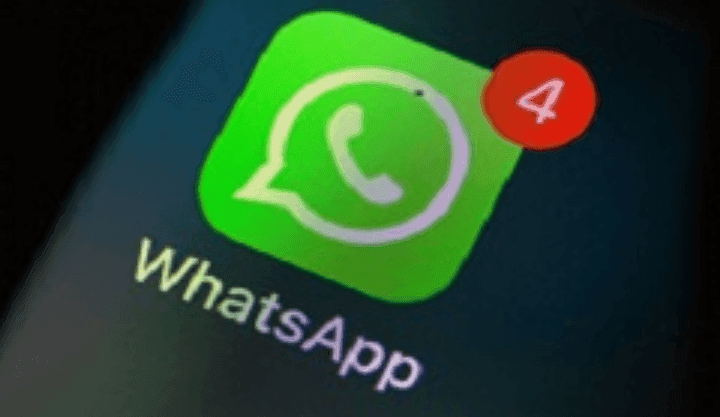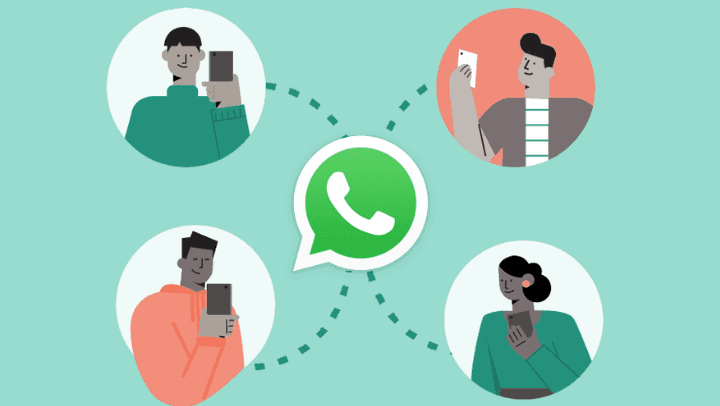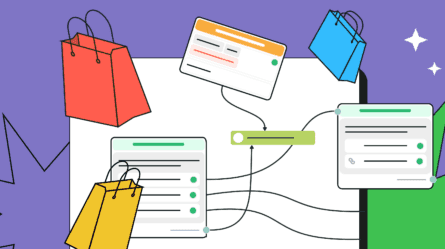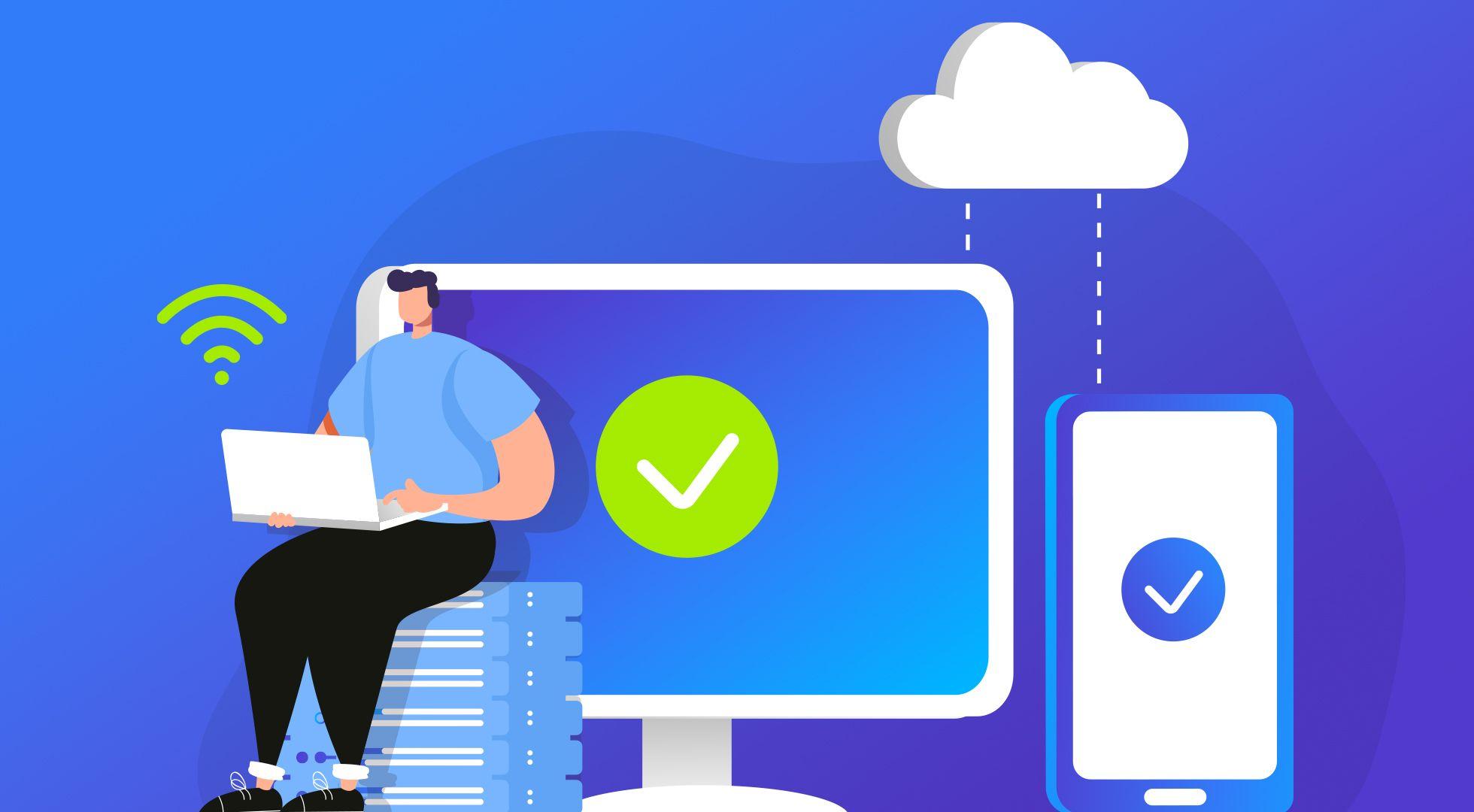网站优化

Subscription confirmation email
A subscription confirmation email is automatically sentin the second step of a double opt-in. At the first step, users leave their email address in the subscription form. In the second step, they confirm they willingly subscribe to future email campaigns from you.Subscription confirmation emails help to ensure you deal only with engaged users with valid email addresses.
Confirmation email goes hand in hand with asubscription form, so watchthe video to learn what subscription form is and how it works.
Why are subscription confirmation emails important?
On the one hand, it makes a subscription process longer, thus, increases the risks of churn. But what is more important, using subscription confirmation emails, ensures your future email campaigns will be addressed to only interested users, who willingly and consciously joined your list.
It also improves the deliverability of your emails alongside with sender reputation. That’s becausea mailing list gathered with a double opt-in method shows lower bounce rates.
At last, the double opt-in approach increases your chances of building long-lasting relationships with your audience, so it’s definitely worth your efforts. Does it take a lot of effort to create a subscription confirmation email? Let’s find out!
How to Create a Subscription Confirmation Email
Create a subscription form
Set up a notification about the confirmation email
Edit the confirmation email
With LIKE.TG, a confirmation email is created in one go with a subscription form, and you can customize it for each form you place on your website. Here’s what you need to do:
Step 1: Create a subscription form
Go to a “Subscription forms” tab in your LIKE.TG account and click “Create a new form.”Drag and drop the elements like input, checkbox, and radio buttons and customize everything to your liking. You can see a screenshot of a form builder below.
After that, move to the “Form options” to set up all the other elements, including the confirmation email.
Step 2: Set up a notification about the confirmation email
Once a user hitsthesubscribe button, they usually see a notification sayinga confirmation email has been sent to their email address. It is set up by default, like in the example below, but you can customize it if you want.
Step 3: Edit the confirmation email
Here we are! A subscription confirmation email also has a preset text, like in the screenshot below. You can also change it according to your style of communication.
Before you add a subscription form to a web site with a set-up confirmation email, create a “thank-you” page that will appear to a new subscriber when they click the confirmation link.
Now that you know how subscription confirmation emails work let’s see some examples from the well-known brands.
Subscription Confirmation Email Examples
Leica. In this email, the brand reminds what benefits the user will earn and promises customization after the subscription is finished.
Booking.com. This confirmation email is written in a formal tone, informing that a click on a link gives full access to the account.
EzyDog. It also sounds formal, reminds about the types of emails the subscriber will receive in the future, and offers support if the user has any questions.

Splash page
A splash page is a standalone web page that emerges before users enter a company’s site. This page can include graphics, animations, or brief information to grab attention and set the site's tone. A splash page isn’t the final destination of users as it does not contain the primary content.
In this article, we’ll unveil why you should use a splash page and how it differs from a landing page. We’ll also show you how to create an effective splash page and provide some helpful tips and examples.
Why should you use a splash page?
A splash page can help business owners attain their primary business goals in various ways. Below, you can find a list of reasons that might make you consider using a splash page for your company:
Promotion and marketing. Marketers can promote special events, deals, and discounts with splash pages. Adding information about exclusive deals to splash pages allows you to establish interaction, encourage engagement, and improve visibility.
Event promotion. If your business is involved in events, product launches, and conferences, a splash page will help you provide participants with details about upcoming events, launches, webinars, etc.
Attention-grabbing introduction. A catchy message, exclusive deal, or exciting event featured on your splash page can be a great introduction to your company’s site. It will help you stay top of mind and establish interaction.
Collecting email subscribers. Splash pages enable you to effectively gather email addresses of potential customers. They always include clear and visible call-to-action buttons encouraging subscribing and receiving updates regularly. As a result, you’ll have a long mailing list and an additional channel for nurturing your prospects.
Announcements and updates. You can incorporate a splash page for announcing important events or providing subscribers with updates on your product or service. It can cover various scenarios, such as changes to your website, product launches, and any other information you feel is necessary when users discover your brand.
Now that you have some reasons to incorporate a splash page into your marketing efforts, it’s time to find out the difference between a splash and a landing page.
Splash Page vs Landing Page
Splash and landing pages aren’t the same because they serve different business purposes. In this section, we’ll compare the two in detail to identify the main dissimilarities.
A splash page is a standalone page that serves as an introduction to a website and usually includes a single message, visual, or animation. This page often has a skip option since not all users like its visual impact. The content featured on a splash page is minimal, including images and straight-to-the-point messages rather than detailed information. Since splash pages have attention-grabbing elements, business owners utilize them for announcements, promotions, and events.
A landing page is aimed at gaining conversions. These might include efforts related to lead capturing, product promotion, or other desired actions. A landing page contains detailed information about a specific product, service, or offer, applying testimonials, benefits, and visible CTAs encouraging conversions. It can educate potential customers and lead them toward a specific action that brings prospects toward purchase. You can encounter brands using landing pages for paid advertising, social media promotions, and email marketing because they help. With LIKE.TG, you can build compelling landing pages within minutes without knowledge of the code using pre-built templates.
Now that you clearly understand the main difference between the two terms, let’s proceed to the next section to explore how you can develop an effective splash page.
How to create an effective splash page?
Building an effective splash page requires your team to map everything out, identify your key goals, analyze the target audience, and ensure a seamless user experience. Below are the steps you should take to create a powerful splash page that brings you towards achieving your main objectives.
Identify your key goals. Every splash page should have a main purpose, so think about this before creating one for your company. It can be a tool for promoting your new event, showcasing product launches, or collecting prospects’ email addresses. Regardless of the main objectives, identifying them will help you make well-informed decisions on splash page design, elements, message, and other aspects.
Understand your target audience. To create a splash page that resonates with your potential clients, you need to know the preferences and interests of your target audience. Consider conducting short research that will help you find a relevant message and visuals and encourage prospects to complete the desired action.
Keep your page simple. Make sure that your splash page features only the most important information in brief. Your content should be concise, focusing on the main message and call to action button. It will help you avoid overwhelming leads with unnecessary information.
Add compelling visuals. Images or graphics included in your splash page should be high quality and attention-grabbing. Since visuals are the first thing users see, you should ensure that they look good on the page, enticing prospects to convert.
Create a brief message. Your message should communicate the main purpose of your splash page. That’s why you need to create a compelling headline and copy supported by visually appealing images. It will prevent you from overwhelming your prospects and encourage the desired action.
Add prominent CTAs. Every splash page has a business purpose, so it should include a clear and visible call to action button. Splash pages vary and allow you to encourage site visitors to subscribe for updates, enter your company site, or receive special offers.
Ensure responsive design. Since many potential customers use their smartphones to explore information on the web, it’s essential to ensure the mobile-first design of your splash page. You need to create pages that look good on any device and provide a seamless user experience.
Check for fast loading time. Consider optimizing your splash page loading time because it can become the reason for potential clients to leave. You should use compressed images and minimize scripts to ensure users don’t have to wait to explore your message.
Conduct A/B testing. Try multiple splash page versions that suit your main purpose and target audience’s needs. Consider implementing A/B testing to find the perfect combination of visuals, messaging, and CTAs. By trying several options, you’ll be able to identify elements that work best with your audience.
Now that you have a step-by-step guide on creating an effective splash page, let’s explore some tips to grab attention and encourage site visitors to action.
8 Splash Page Tips
In this section, you’ll find a list of tips that will help you develop a clear and attention-grabbing slash page. So let’s dive in.
Keep it action-oriented. To reach the primary goals of your splash page, you need to make it action-orientated. Consider including all the elements necessary for users to complete the desired action. It can be a visible CTA, concise message, and visuals that entice site visitors to subscribe to your email newsletter, search for items, or purchase with a discount code.
Use a countdown timer. Countdown timers are perfect for limited-time promotions, sales, and exclusive offers. They establish a sense of urgency and encourage users to take action as soon as possible. The fear of missing out helps you reach the business goals you want to achieve through your splash page faster.
Be consistent. The elements and language of your splash page should align with your overall brand tone and messaging style. You need to be consistent across all your channels to establish recognition. In addition to language and messaging, your visuals, color scheme, and fonts should also comply with your branding guidelines.
Entice subscribers with special offers. Exclusive deals, discounts, and offers allow you to attract prospects’ attention and encourage them to complete the desired action. It will help you increase your customer base and improve conversions.
Add a skip option. Your splash page should allow site visitors to skip this standalone page and proceed to the primary content of your website. It will help you improve user experience and ensure that site visitors get the necessary information immediately and complete the actions they strive for.
Add a clear CTA. Since every splash page has a specific goal, you should ensure users can help you reach it. They complete the necessary actions by clicking the call to action button. That’s why you need to create a splash page that has a clear, visible, and concise CTA. It will enable your potential customers to proceed to your offers, events, language and country settings, and other aspects that help you attain your business objectives.
Utilize analytics. If you want to have a clear understanding of your splash page performance, it’s crucial to apply analytics tools. They will help you uncover whether your splash page resonates with your target audience and brings valuable results. After receiving insights into your splash page, you can craft it based on customer preferences, interests, and overall activity on your site.
Add a concise message. Your message should be brief to communicate the main idea behind your splash page. With a short and sweet message, you’ll be able to grab attention and encourage users to explore your content further. Support your message with visuals to interest site visitors and make them discover more information about your brand.
Now that you know the best practices, let’s discover some excellent splash page examples. They will inspire you to create a splash page that encourages action.
Splash Page Examples
You can find numerous examples of splash pages widely used by brands. In this section, we’ll provide some successful examples to inspire you.
Fighting Pretty
Fighting Pretty, an NGO established to support women during their cancer treatments, incorporates a splash page to encourage new users to join the community. This non-governmental organization shows new site visitors a short and to-the-point message, participants’ image, and a visible and clear call to action button. This splash page matches the organization’s color scheme, fonts, and style, aligning it with the primary website.
Zara
Zara, the famous clothing brand, is an excellent example of the right usage of splash pages. When you proceed to the company’s website, you’ll instantly see a page full of visually appealing visuals and the opportunity to choose country and language preferences. This splash page aims to ensure the best user experience for site visitors, allowing them to explore items in their language, currency, and delivery options.
CB Creative Blog
When users open the CB Creative Blog website, the first thing they see is a splash page. The company offers potential subscribers to explore daily design news, reviews, and how-tos once they sign up for its email newsletter. The main purpose of this splash page is to increase the number of contacts on the mailing list. The page’s message is short and clear. After reading the main message, site visitors can share their emails and take the desired action by clicking on a call to action button.
Congrats, now you know what a splash page is and why it’s useful for your company. Hope that our guide, tips, and examples will help you create an effective splash page that grabs attention and allows you to reach the desired goals.

Strategic planning
Strategic planning is setting up a company's long-term goals and defining the ways to reach them. It helps highlight a brand’s priorities and create a roadmap for future development.
In the article, we explain what strategic planning is and why it is vital, and describe its benefits and models. We also provide the steps to help you develop a strategic plan that will boost your company in the market.
Why is strategic planning important?
Cascade states that business leaders in 49% of organizations spend only one day a month analyzing how they implement their strategy. Such an attitude may badly influence their companies’ success because strategic planning requires more effort to be effective. Discover why it is vital for your business’ success.
Strategic planning helps you define a clear mission and direction in which you want to move your brand. You can use them as a guideline to align your everyday decisions with the business’s main goal. It lets companies reach their objectives faster and manage time wisely.
Also, this process influences your staff’s motivation positively. When your employees have a clear vision of the company’s future, they feel more inspired to work hard and reach the goal as fast as possible. Moreover, it gives them a better understanding of the company's processes and makes communication between employees and the employer more productive.
Finally, strategic planning lets you evaluate the efficiency of your work and improve the roadblocks immediately. You can use the strategy as a benchmark to discover the issues with your company’s development. This is the reason to revise it regularly and track your business performance in an ever-changing market.
Now you understand why strategic planning is so essential. Continue reading to discover the main benefits of this process.
4 Benefits of Strategic Planning
It is difficult to overrate the importance of a strong strategy for long-term company development. We explain the main benefits of strategic planning and how they influence your brand’s performance below.
Measurable goals and easy progress evaluation. A clear strategy should include specific and concrete objectives you will use as guidelines for future decisions. They help align the brand’s efforts with pre-set goals to reach them faster. Also, it is easier for companies to measure the effectiveness of their activities. A strategic plan gives a sense of direction and lets business owners make adjustments to the current strategy to optimize business performance.
Better staff motivation. According to Harvard Business School, 95% of employees do not understand or are unaware of the company’s current strategy. It is one of the reasons why brands fail in their implementation. However, when your managers understand the direction your company moves, it inspires them to work better and be more creative. Employees understand the link between their performance and compensation, so they try to work more productively.
Effective crisis management. Strong strategies make businesses more durable and resistant to market changes. The planning process lets companies evaluate possible roadblocks and weaknesses and prevent them before they influence their performance. It helps save time and resources necessary to overcome problems if they occur.
Increased profitability. According to Balance Marketing Group, brands that use strategic plans are 12% more profitable. It happens due to effective crisis management, more goal-oriented actions, and higher employee motivation. A strong strategy gives you a competitive advantage and helps turn all company’s efforts into the best results to increase revenue and market share.
Understanding all these benefits motivates many business owners to build strategic plans for their companies. Find out the models you can use in the next section.
10 Strategic Planning Models
There are many ways to create your strategy and plan a brand's development. Some models appeal to small businesses, some to huge companies, and some are universal. We'll review the peculiarities of the most widespread models below.
The basic model is rather simple and ideal for small businesses and startups. The first step is to define the brand's mission, values, and goals. Then you should highlight the ways to reach these objectives and create an action plan that will serve you as a roadmap. Finally, this model requires continuous tracking and optimizing the strategy to improve the results.
SWOT analysis is necessary to define the advantages and disadvantages of your current strategy. It is an acronym that means ‘strengths, weaknesses, opportunities, and threats.’ You can use SWOT analysis to optimize the company’s processes. Raise the success of your performance by solving problems and empowering the strengths of your company.
An issue-based model uses SWOT analysis as a framework to build more complex strategies. Marketers identify the most appealing scenarios and develop action plans to overcome possible issues. Then, companies allocate resources to turn these strategies into reality and optimize them constantly to improve their effectiveness.
The PEST model is similar to the SWOT analysis, but it focuses on external factors. This acronym means ‘political, economic, sociocultural, and technological.’ All these factors can influence your company’s health and performance, so it is vital to evaluate them and find the possible issues. Build a plan and solve them to strengthen your company. You may also expand this model and use the PESTLE acronym to include legal and environmental factors in your study.
The scenario model is useful if many external factors influence your company’s performance. It involves studying various market elements, such as competition, trends, changes in consumer behavior, etc., evaluating their effect on your strategy, and creating from 2 to 5 possible scenarios for future development. You should build the most appealing and worst scenarios one suggest ways to overcome problems.
A strategy map is a diagram that shows the logical connections between the situations that may occur and the company's actions. It is better to combine this visual tool with other models, such as basic, issue-based, or scenario one. A well-defined map lets you create a clear vision of your business goals and how you are going to reach them, unify all the data in one strategy and discover how market elements affect each other and influence your brand’s development.
Porter’s Five Forces model evaluates the influence of the most important external factors on your company. They include the threat of entry to your marketplace, the threat of substituting your products, the bargaining powers of consumers and suppliers, and the existing competition. You should examine all these factors, determine how they will influence your strategy, and suggest ways to reduce their impact and optimize the company's performance.
The VRIO model can be a framework to strengthen your existing strategy. Marketers use it to identify the competitive advantages of their products. VRIO is an acronym for ‘value, rarity, imitability, and organization.’ You should examine these qualities of your products, identify the strongest ones, and highlight them in future promotional campaigns to stand out from the competitors. If you also discover the weak elements of your strategy, improve them and make your product even more appealing.
An organic model focuses on the brand’s values and is based on the self-organization of people who have the same goal. It includes three main steps. Firstly, you identify the company's values and vision of its future development together with your team. Secondly, all employees create personal action plans on what they will do to reach the main goal. Finally, all workers take responsibility for turning this plan into reality and report on the progress.
An alignment model aims to structure the important perspectives of business development. You need to examine and evaluate technology and competitive potential, the service level, and the strategy that drives your company’s performance. Ideally, if all these factors work together and empower each other. If there is some discrepancy between them, you will discover what to improve to strengthen your strategy implementation.
Besides the fact that these models are rather different, the main steps in planning your company’s performance are similar. Continue reading to discover how to build a strong strategy to boost your company on the market.
5 Strategic Planning Steps
According to The Economist, 39% of brands state that one of the main reasons for their success is the skilled implementation of pre-built plans. Find out the main steps to create an effective strategy and implement it accurately.
Define your mission and values. This step is required to identify the direction you want to move to. Also, a clear understanding of your mission and values lets you align your actions with the messages you want to transmit. Identify how you want to influence consumers’ lives and what experiences you want to provide.
Study your existing position. You can use SWOT or PEST analysis to create a holistic image of the current situation in the company. Collect data about consumers, study your competitors and analyze internal factors that influence your sales. Then define your strengths and weaknesses. As a result, you will understand what aspects of your market performance you should focus on.
Set measurable goals. It may be difficult for you to work with a few objectives at once, so it is better to prioritize them. You may set SMART goals, which should be specific, measurable, achievable, realistic, and timely. Such an attitude lets you manage and achieve them easier. Remember that also your goals should correspond with the mission and values you have defined before.
Use one of the planning models and create a future strategy. It is time to build a step-by-step plan to reach your objectives. Focus on the initiatives that strengthen your long-term position. You can mix a few planning models to create a more complex strategy. Define possible scenarios and identify how you will react to the market changes to prevent potential issues.
Implement and optimize your strategy. Determine the resources you need to turn your plan into reality. Measurable pre-set goals will let you analyze your strategy and identify the roadblocks quickly. You may also need to reevaluate the current plan after a certain time to optimize it and make it even more effective. Remember that your strategy should be flexible, so update it regularly.
Congrats, now you know what strategic planning is and why it is important, understand its benefits and models. You can also build a strategy for your company to optimize its performance and raise profits.

Storytelling
Storytelling is using a narrative to encourage people’s imagination, transmit certain messages and motivate the audience to take action. Marketers use storytelling to increase consumers’ brand loyalty and inspire them to buy a company’s products.
In the video below, Alex reveals the mystery of the art of storytelling. Get inspired!
In the article, we explain what storytelling is and why it is essential, and describe its types and effective techniques. We also define the elements necessary for a good story and provide examples of amazing storytelling.
Why is storytelling important?
According to Search Engine Watch, 62% of B2B marketers are sure that storytelling is a powerful tool in their content marketing strategy. We explain why it is so important and how it can boost your company below.
Firstly, stories help companies draw consumers' attention. They engage people and, in such a way, raise their interest in your brand and increase brand awareness. You can tell stories on different platforms: from TV advertisements to social media posts, from podcasts to video projects. It helps attract more buyers to your brand, especially if the story becomes viral.
Secondly, compelling stories resonate with consumers’ feelings and evoke certain emotions. It allows companies to show people that they share their pains and needs. In such a way, you can humanize your brand, give buyers a sense of community, make them empathize with your company, and foster their loyalty.
Thirdly, powerful storytelling adds value to your products and helps sell them better. When people are engaged in your stories, they are more likely to stay with your company and become regular clients. Increasing customer lifetime value lets businesses drive more revenue because existing clients spend 31% more money than new ones.
Finally, storytelling is a great way to explain complicated things simply. Some companies promote concepts and developments that are difficult to understand for consumers. The best way to persuade people to buy these products is to connect them with simple ideas and feelings relevant to everyone. You can show how cutting-edge goods can improve people’s lives to raise their interest.
Now you understand how stories influence consumers’ behavior and help companies in their product promotion. Continue reading to discover the elements that help create an effective story.
What makes a good story?
Consumers consider the story interesting when it tells about something important and relevant to them. However, it is not enough to make your storytelling engaging. Discover more on what creates a really good story in this section.
Central message and plot. Define the main idea of the story you tell. It should be a strong morality that influences the listeners’ emotions and reminds them about the importance of certain things. Once you define this core message, build a plot around it. Your story needs a beginning, climax, and end. Remember that all these elements should be connected and describe the central message.
Conflict. It is impossible to create an engaging story without tension. You can combine internal and external conflicts to keep people on edge and motivate them to listen till the end. Describe the challenges your characters face while trying to reach their goals. It helps evoke the audience's feelings and connect consumers with your brand through powerful experiences.
Characters. Memorable personalities are one more necessary element in a good story. All characters should have their own goals, motivations, voices, strengths, weaknesses, challenges, and the ways they overcome them. Appearance is also very important. It should coincide with the inner world of the characters and distinguish them from each other. Remember that all personalities should play a certain role in the story and influence the plot.
Setting. Choose remarkable places that coincide with your characters’ personalities and help the plot develop. The setting should reflect the atmosphere of your story. For example, if the plot is mysterious — you can choose dark and strange places; if it is funny — the setting can be bright and attractive.
Rhythm and structure. To keep listeners engaged, you should change the rhythm of the story. Mix long and short sentences, paragraphs, or scenes. Avoid monotonous narration. Also, your story should have a clear structure. It does not matter whether you tell the story orally, in writing, using visual elements, or even through play — a clear beginning, middle, and end of the plot are required. They should work together to transmit the central message of the story.
The ending. The listeners need to have a clear understanding of the story’s resolution. It should not necessarily be a good one, but it should reflect the main idea of the plot. If you use storytelling in marketing, it is good to use a call to action at the end of the narrative. In such a way, you give the audience instructions about their future actions and come to the logical end of the story.
Understanding these elements can help you create powerful stories to influence your audiences’ buying decisions. Let’s go further and discover the main types of storytelling and how to use them in marketing.
4 Types of Storytelling
Now storytelling is not only a way to entertain but a powerful tool in brands’ promotion. To use it in marketing effectively, you need to know the main types of storytelling.
Oral storytelling. It is the oldest form of storytelling that plays a vital role in the cultural traditions of many countries. Singing songs, telling stories, and reciting poetry in front of the audience were the first forms of oral storytelling. Now it is still alive and continues to develop. For example, we can observe oral storytelling on the radio or podcasts. Also, people tell jokes or stories from their lives on social media, such as TikTok or Instagram, creating a mix of digital and oral storytelling.
Written storytelling. It is one of the most popular forms of telling stories. Books, newspapers, magazines, banners, etc. are examples of written storytelling. People read them for entertainment, education, and discovering something new, so marketers often use this form of storytelling to promote companies and products. There are also many written stories on the Internet, which means that this type of storytelling mixes with the digital one.
Visual storytelling. Paintings and drawings have been a part of human culture for years. Now the term ‘visual storytelling’ is much wider. Movies, serials, photos, videos, infographics, animations, and memes are only a few ways of telling stories. Companies often use visual storytelling in their marketing campaigns. You can watch ads on TV or discover the brand’s story through its photos on social media. We can also mix this form of storytelling with the digital one.
Digital storytelling. The newest way of telling stories conveys all the previous forms through the Internet. Content marketing is a way to promote companies on the world wide web. Brands can use photos, videos, articles, blogs, audio recordings, etc., or combine them and create more complicated forms of storytelling. Also, the Internet lets developers use games and tell their stories through play. This way of storytelling turns people who passively receive the data into active creators and makes them more engaged in the story than anytime before.
Now you know 4 types of storytelling and how to use them in marketing. Continue reading to discover effective techniques that can help you increase the effectiveness of your stories.
5 Effective Storytelling Techniques
According to the research by a professor at Stanford University, stories are the most effective way to deliver data. When his students heard a speech that included storytelling and facts, 63% remembered the stories and only 5% remembered individual statistics. This fact proves the ultimate power of storytelling. Discover how to increase its effectiveness even more in this section.
Show what happens and use scene-by-scene construction. This tactic is the most effective in written storytelling. Instead of telling about the events, you should describe them. Transport the audience to the scene, and make them hear and feel the same as your characters do. It can help you immerse the readers into your story, engage them and influence their perceptions. Avoid missing some scenes and telling about them afterward. Remember that it is always better to show something than to state the fact of an event.
Make the story dynamic and easy to relate to. To engage the audience, you should evoke people’s emotions and feelings that are easy to understand. Don’t be afraid to show your or brand’s weaknesses and the ways you overcome them. Such elements make your storytelling more personal and especially captivating. However, you should avoid irrelevant details that do not boost the plot or influence your characters to keep consumers’ attention all the time.
Define a hero and an enemy. Strong characters are one of the most important elements of the story. People always need someone they will support and someone they will hate. Sometimes bad characters can be things, natural phenomena, or events that do not let positive ones reach their goals. The climax of the story is the biggest fight between the enemy and the hero.
Create a feeling of suspense and add unexpected events. It is also about continuous tensions that keep readers’ or listeners’ attention. You can create a non-linear storyline and start from the middle action or from the climax to hook the audience at once. Add surprises to your plot that keep conflict intensivе, make the audience empathize with the characters, and create a memorable story.
Improve your dialogues. It is one of the most challenging parts of the stories to write. Note that your characters should sound realistic and individual and stay consistent in their voices and communicational styles. Also, do not use dialogues if they don’t serve the development of the plot. Some changes in the characters’ personalities or actions should happen after every communication.
Remember these techniques to create strong stories that you can use in your company’s blogs, social media, or during promotional campaigns. In the next section, we provide examples of brands that used effective storytelling to boost their company.
Storytelling Examples
To use storytelling for brand promotion, your stories should be interesting, engaging, and persuasive. Moreover, they should appeal to your audience and coincide with the company’s values. Below we provide examples of effective storytelling from well-known companies and highlight the peculiarities that made them so powerful.
Disney
‘The Little Duck’ is a commercial by Disney that tells us a story about how dreams come true. In the video, we see a duckling who finds a comic book about Donald Duck. He likes the story and becomes infatuated with the main character. However, the bad weather makes his family to fly away, so the duckling leaves a comix. They have been flying all night and, eventually, find a new home. The little duck realizes that they are in Disneyland Paris and meets his hero Donald Duck in real life.
This cute story is an amazing advertisement for Disney’s amusement park. In 75 seconds, we become completely fascinated by the character's fate and feel happy when the video ends well.
Eva Stories
It is not a promotional campaign, but Eva Stories is an amazing example of storytelling witha critical social mission. A story describes the last days of 13-year-old Hungarian Jew girl Eva who lived in 1944. Conducted on Instagram Stories, the campaign aims to educate people about what happened during the Holocaust. It is based on the real diary belonging to Eva Heyman, who died at Auschwitz on October 17, 1944.
Below is a screenshot of Eva's Instagram, which has more than one million followers. There are stories from February 13 to March 31 that depict her life before and after Germany’s invasion of Hungary. They had 300 million views in less than 48 hours and made many people worry and feel sad about the events of the Holocaust that ruined so many lives.
Coca-Cola
This company conducted a campaign using AR technologies to tell short stories connected with their brand. Buyers could point their phone’s cameras at Coca-Cola’s can to see small characters on the screen. There were 12 short stories; each one had a conflict and a positive resolution. In the end, the characters shared a can of Cola and had fun.
There is a video about the creation of this storytelling campaign. The company aimed to attract consumers’ attention to their products using new technologies and interactive promotions. As a result, the combination of augmented reality and storytelling was extremely successful and became one of the most unusual advertising campaigns in the brand’s history.
Apple
The director Michael Gondry created the film ‘Detour’ as a part of a promotional campaign for the iPhone 7 Plus. It aimed to show the quality of Apple’s camera and its features, such as animation, filming underwater, time-lapse and slow motion. The company also provided additional online masterclasses to explain to buyers how to create such amazing videos.
‘Detour’ tells us a story about a tricycle that a family lost during their journey. The girl who owned it was very upset, but the story had a happy ending. You can observe the adventures of the tricycle and its young owner for 11 minutes and, finally, feel happy about the unexpected outcome of the story.
Congrats, now you know what storytelling is and why it is important, understand the distinctive features of a good story and techniques for powerful storytelling. Also, you have discovered inspiring examples from popular brands that can motivate you to use stories for your company’s promotion.

Squeeze page
A squeeze page is a web page made for capturing potential customers’ email addresses. It’s a common practice for these pages to offer free ebooks, educational emails, videos, and more, in exchange for a visitor’s email address or other data. At first sight, squeeze pages resemble landing pages, but they’re slightly different.
What is the difference between a squeeze page and a landing page?
In short, a squeeze page is a specific type of landing page; it’s made for one purpose – to collect users' email addresses. Apart from that, landing pages can aim at selling a product or service.
Typically, squeeze pages are shorter than landing pages. They contain a minimal amount of graphics, details, and additional information. Their task is to start a buyer's journey while landing pages work at different stages of the sales funnel.
A squeeze page can provide you with valuable leads. To nail it, optimize the page’s conversion rate from the beginning. Let’s unpack the several ways to compile a high-converting squeeze page.
As squeeze pages resemble landing pages, you can use some tips on building the latter as the foundation of your squeeze page. Our guide on boosting landing page conversions will come in handy. To deepen your knowledge of what makes a good squeeze page, read on to learn more about the best practices.
How to Create a High-Converting Squeeze Page
Define the Right Target Audience
Build an Appealing Offer
Create a Killer Headline
Think up a Great Design
Create a Сlear Сall to Action
To leverage a good conversion rate, learn how to compose your squeeze page. We’ve picked five marketing, design, and copywriting tips to help you get started with your highly-converting page.
Define the Right Target Audience
To hook and retain your squeeze page visitors, you need to spot your audience precisely. Don’t content yourself with vague characteristics, such as “30-year-old women.” Find out your audience’s values, interests, and goals. You can extract more information from your customer profile. If you don’t have one, check our guide on compiling a buyer persona.
Address your visitors' pain points and interests, as Mindflash did in the example below. The company clearly stated its target audience – people eager to launch a training program. Moreover, Mindflash stressed the main advantage of their proposal. It helps customers build an effective program and keep the cost down.
Build an Appealing Offer
The key to success with a squeeze page is including a relevant and irresistible offer to your target audience. Usually, it is a lead magnet – PDF, report, checklist, or other types of useful downloadable content.
It might be tempting to give your visitors a monumental piece of content. But, don’t overdo it so as not to scare your audience away. Enormous books are intimidating; barely anyone got the whole way through War and Peace for this reason.
Give your audience something concise but valuable, as Incomediary does. The blog went for a compilation of 110 headlines that helped attract readers. This ebook is short and easy-to-use – just copy and paste the headlines.
Create a Killer Headline
By the way, take care of your squeeze page’s headline and supporting headings as well. These parts of any web page draw immediate user attention and can make or break further reading.
Here’re some tips on how to compose a headline that hooks attention:
Address your reader’s pain points and offer a solution – your product.
Indicate the product you are offering from the beginning.
List the benefits a reader will get with your product, such as a conversion rate increase.
Add figures – they’re clear-cut indicators of value.
Your supporting headings should relate to your headline perfectly. Otherwise, the whole work will fall flat, because it will confuse readers.
Look at the A+ squeeze page Fisher Investments provides. In the headline, the company addresses its audience’s fears of financial hardship. The supporting heading kills two birds with one stone; it gets to the bottom of the offer and highlights the simplicity of using this guide (just 15 minutes to read!).
Think up a Great Design
It takes a visitor only 50 milliseconds to decide whether a squeeze page is worth staying on or not. The page’s design is a golden opportunity to attract more readers and boost your conversion rate.
To create a stunning squeeze page, pay special attention to its structure; it should be crisp, airy, and easy to skim. Give some thought to color psychology; think of the association you want to create with your product and go for a matching shade. Finally, pick up the perfect visuals; images should be relevant, eye-catching, and high-quality.
Here is an example from Fathom. To promote their travel guide, the company chose a background image with palm trees and a turquoise sea. This shot resembles the cover of the eBook on offer. The squeeze page has enough space between all the elements and looks airy. The color palette is unified and harmonic.
Create a Сlear Сall to Action
A call to action is a milestone for a high-converting squeeze page. Pay attention both to the design and the copy of your CTA button. For the visual part, use vibrant and contrasting colors and make sure the button is big enough for both desktop and mobile users to easily engage with. Leave some space around it and choose the right location (the best place is in the top left corner).
To drive conversions with the copy, go for a single clear-cut call to action. Pages with only one call to action convert 3% better than those with five or more links. To reinforce the message, use imperatives, such as “click” or “subscribe”.
The lead generation service, Carrot, knows a thing or two about good calls to action. The CTA button is the same color as the bottom of the eBook cover; it creates symmetry and catches the viewer’s attention. The copy also works well being clear, imperative, and urgent by using the word “now.”
5 Squeeze Page Best Practices
Go for Minimal Form Fields
Use Multi-Channel Forms
Make the Benefits Visible
Include Social Proof
Add Visuals Effectively
Practice makes perfect, so we’ve found five best practices brands stick to with their squeeze pages. We’ve also added some tips on implementing them into your strategy.
Go for Minimal Form Fields
You probably hate seeing the subscription forms with 5+ fields to fill in; so do your visitors. To get the maximum number of leads, minimize the number of form fields. The best option is to only ask for an email address or name and email address.
If you want to segment leads from a squeeze page, the email field alone is not enough. Give multi-step forms a shot. In other words, long forms split up into several pieces. Look at the example of such a form below.
At first, a viewer only sees a button and gets access to the form with five fields after a click. Thus, the process looks less intimidating, and a user is less likely to quit.
Use Multi-Channel Forms
Our inboxes are overloaded. That makes it more difficult for your message to reach subscribers. Moreover, some users hardly ever use emails and spend most of their time on social media or messaging apps. The solution? Applying multi-channel forms. They allow visitors to subscribe with their email, messenger, or social media account.
To build beautiful, responsive, and adjustable multi-channel forms, try LIKE.TG. Below is an example of how it may look like. We’ve customized the form design and incorporated the buttons to subscribe to email and our Facebook and Telegram chatbots. Sign up with LIKE.TG and create as many forms as you like for free.
Make the Benefits Visible
It’s a good idea to list the advantages of your offer; this trick helps visitors make a decision. It’s even better to make these benefits more evident with icons, infographics, or images.
If your squeeze page offers a modest eBook or a newsletter, use icons instead. Make each of them unique and relevant to the advantage they illustrate. For a dose of inspiration, check out Skyeng's example. The company highlights the benefits of its product with custom pictures and screenshots.
Include Social Proof
Social proof increases the credibility of your offer and the conversion rate as well. For instance, products with over 50 reviews have a 4.6% increase in conversion rates. It's an overwhelming amount for a squeeze page. However, even a couple of testimonials can make a difference.
To get your head around applying social proofs, consider following Backlinko's example. The company includes reviews both on the newsletter and the service itself. Moreover, Backlinko added the logos of media resources that have featured the brand.
Add Visuals Effectively
Visual content drives 84% more views and 94% more clicks than the text-only content. Thus, using visuals is a golden opportunity to boost your squeeze page views and conversion rate. To leverage it, the visuals should be relevant, high-quality, and attention-grabbing.
So, a win-win decision is to add product images, a guide, or an eBook to your offer. Look at this example from Webprofits. The company applied quality images to their guide, which looks like a new beautiful paper book.
If you want to go for something a little more creative, try adding a short video to your squeeze page. 83% of marketers say video content has helped them generate leads. You can apply a short overview of your product, reviews from happy customers, creative videos, and so on.
Eager for more practical information? Read and check out some more examples of a few squeeze pages we’ve picked for you.
4 Squeeze Page Examples
Examples are inspirational and helpful; they allow us to borrow the best and avoid the worst in our own approach. Let’s learn what other brands do right on their squeeze pages and what can be improved.
Pipedrive
The software company, Pipedrive, shows a classic example of a well-made squeeze page. Offering free instructional emails, Pipedrive highlights its advantages.
Its minimal sharp design works well for this page. The company uses three colors, which makes the green CTA button stand out. The copy is concise yet persuasive. The subscription form is simple, which works best for a squeeze page.
The best part of this page is that it includes social proof. Pipedrive added reviews from real people with their photos and occupations. This move makes the credibility of the product skyrocket. To reinforce this effect, the company shows the number of course subscribers.
Rosetta Stone
The education technology service, Rosetta Stone, knows a thing or two about using visuals. The company chose vibrant colors for the squeeze page in the example below. Better yet, it uses animated images of its product – the language learning app. This way, Rosetta Stone kills two birds with one stone; it shows the product and stresses the benefits of using it for the audience.
The work with social proof is excellent as well. The company subtly interweaves reviews, clients’ logos, and statistics into its squeeze page.
The page may seem a bit overloaded, especially contrasting with the previous example. Nevertheless, the CTA buttons are noticeable. Although there is some space for improvement, the copy works well.
Summit in a box
The virtual summit system, Summit in a Box, nails its squeeze page with an appealing offer. The company provides subscribers with a marketing plan for their summit. The eBook includes instructions on email and social media promotion for webinar coordinators and speakers. This guide looks so easy-to-apply and handy, that you instantly want to get it.
Summit in a Box seems to cut corners with this copy; it needs a sharper structure. The benefits of the eBook would look better as a bulleted list.
The visual part of the page is easy-on-the-eyes. The image of the product is nice, and the background doesn’t make the copy illegible. The CTA button is eye-catching, and the form is concise.
TapInfluence
Influencer marketing service, TapInfluence, has staked almost everything on a sophisticated design. The company went for a flashy header on its squeeze page. One half of it shows the eBook the service offers, and the other reflects a part of the cover.
The CTA button is visible, although it’s not so bright. TapInfluence could have reduced the number of fields or gone for a multi-part form. Nevertheless, the subscription process doesn’t look intimidating.
Another advantage of this page is its copy. It starts with addressing the audience’s pain points and offering a solution – the eBook. Further, you can see a brief description of the guide’s content and the list of benefits you can get from it.
We have unpacked a few hacks and examples of creating high-converting squeeze pages. To maintain communication with leads from them, consider email marketing, or reinforce your lead strategy with SMS, messenger chatbots, and web push notifications. Sign up with LIKE.TG to benefit from implementing these tools into your marketing strategy.

Straight rebuy
A straight rebuy is a buying situation where a company reorders the same products in the same quantity from the same supplier. In this purchasing situation, buyers are likely to skip researching suppliers and products since they have previously ordered from this specific vendor.
What is the difference between a straight rebuy and a modified rebuy?
Purchasing situations vary and can change when the market changes. Let’s break them down into three types:
new buy;
straight rebuy;
modified rebuy.
New buy
A new buy, also called a new task, is a buying situation in which a company places an order with a supplier for the first time. This purchasing type takes longer since you need to conduct in-depth research and analysis on products from various suppliers to make the right decision.
Straight rebuy
This means that an individual or a company only needs to reorder from the same vendor without changing any of its elements. In this buying situation, a company expects the order to be on time since the supplier already knows the details and can plan production. There shouldn’t be any confusion or misunderstandings between a supplier and the company that orders products because of their previous collaboration.
To keep loyal customers, suppliers should maintain product and service quality and automate their reordering systems to save clients’ time. Additionally, they can offer new products and services to capture more markets. Manufacturers prefer this buying situation because the client doesn’t consider alternative suppliers to buy from. As a result, they have a stable constant revenue stream.
Modified rebuy
This means that a company wants to reorder but needs to modify some elements of their previous orders. The change can be in terms of the supplier, delivery time, packaging, price, quality, or quantity. This modification can result in delayed order delivery because the supplier has to change it. Sometimes it can be time-consuming. In some cases, a modified rebuy can cause the wrong supply of goods to the clients. Also, it can require research to find a good supplier or to make changes to an order.
As you can see, these purchasing types have several differences and are used in different situations between your company and a supplier during the reordering process. Now that you know the difference, let’s walk you through the examples.
Examples of a Straight Rebuy
Dunkin' Donuts and Blue Diamond Growers
Starbucks
Boeing and King Aerospace Aircraft Support Services
Here you can find several examples of a straight rebuy to see the process in action.
Dunkin' Donuts and Blue Diamond Growers
In 2014, the multinational coffee and donut company introduced almond milk at most of its restaurants. This is a plant-based alternative for vegans or people who don’t consume dairy products. So the brand needed a regular supplier of milk for their new product. Blue Diamond Growers has supplied almond milk to Dunkin’ Donuts since 2014 when its product was first introduced to guests of the famous donut brand.
Starbucks
This corporation is known worldwide as the largest coffeehouse chain. The brand entered Southeast Asia a long time ago, and today it sources a great amount of arabica coffee beans from Indonesia (Sumatra), the Philippines, Thailand, and Vietnam, Latin America, etc. So, it has regular suppliers located in the United States, Singapore, Hong Kong, Mexico, Indonesia, India, etc.
Boeing and King Aerospace Aircraft Support Services
In 2019, Boeing, the manufacturer of airplanes mentioned King Aerospace among 10 companies-suppliers of the year that create and supply high-quality products, services, and value for Boeing and its clients. The company expressed gratitude for collaboration that aimed at innovation, process, or product improvement.
Companies can find themselves in different types of buying situations based on the products they want to buy, the information they have, timeframe, etc. A straight rebuy is the most simple buying situation as a company purchases from an approved supplier. The examples above demonstrate this type of purchase in action.

Split-testing
A/B testing was invented to predict the metrics of your mailings. A/B testing allows you to compare elements of your postings and use the more effective variants with the highest delivery rates, open rates, and clicks through.
There are many elements of your email campaignthat you can test, including:
the email subject;
the sender’s data;
the preheader;
the location of the text box;
the heading settings, such as the font and the size;
the main text settings, such as the font and the size;
the calls to action, and their number and location;
the number of photos in the emails;
using animated pictures like GIFs and videos;
the number of links.
For example, imagine you have two subject lines— "Gift for you!" and "We’ve got something interesting for you!" — but you don't know which one to use as you don't know which one will work best. In this situation, you should test them. While conducting the A/B test, LIKE.TG will create two different mailings with two different subject lines.
In the A/B test, you should define the "Choice Criterion," which determines the "winner" variant of the mailings. In our option, the choice criterion is the open rate. When testing the subject line, this is more suitable than clicks through.
Email “A” will be sent to 20% of your address book, as will email “B.” When the results are available, send the “winning” email to the remaining 60% of recipients.
That is how you can increase the metric measurements of your newsletterswith the help of A/B testing.
You can follow this guide to conduct an A/B test for your email campaign.

Startup
A startup is a young company established by one or more entrepreneurs to create unique and irreplaceable products or services. It aims at bringing innovation and building ideas quickly.
In this video below,Alex shares 5 tips you need to know to run a successful startup. Check it out!
In this article, we’ll uncover the types of startups and startup business ideas, explore the reasons to work in a startup, and provide a few steps to build a startup from scratch.
6Types of Startups
Scalable startups
Small business startups
Lifestyle startups
Buyable startups
Big business startups
Social startups
In our modern world, where everyone strives to bring innovation, a good idea isn’t enough to create a startup. To understand the features of different startups better, you need to review the following six types.
Scalable startups. Companies in a tech niche often belong to this group. Since technology companies often have great potential, they can easily access the global market. Tech businesses can receive financial support from investors and grow into international companies. Examples of such startups include Google, Uber, Facebook, and Twitter. These startups hire the best workers and search for investors to boost the development of their ideas and scale.
Small business startups. These businesses are created by regular people and are self-funded. They grow at their own pace and usually have a good site but don’t have an app. Grocery stores, hairdressers, bakers, and travel agents are the perfect examples.
Lifestyle startups. People who have hobbies and are eager to work on their passion can create a lifestyle startup. They can make a living by doing what they love. We can see a lot of examples of lifestyle startups. Let’s take dancers, for instance. They actively open online dance schools to teach children and adults to dance and earn money this way.
Buyable startups. In the technology and software industry, some people design a startup from scratch to sell it to a bigger company later. Giants like Amazon and Uber buy small startups to develop them over time and receive benefits.
Big business startups. Large companies have a finite lifespan since customers’ preferences, technologies, and competitors change over time. That’s why businesses should be ready to adapt to new conditions. As a result, they design innovative products that can satisfy the needs of modern customers.
Social startups. These startups exist despite the general belief that the main aim of all startups is to earn money. There are still companies designed to do good for other people, and they are called social startups. Examples include charities and non-profit organizations that exist thanks to donations. For instance, Code.org, a non-profit organization, encourages school students in the US to learn computer science.
If you consider creating your startup, we’ve prepared five startup business ideas that will inspire you to develop something unique.
5Startup Business Ideas
Create an online grocery delivery service
Start a podcast
Develop a dropshipping business
Create an online language learning app or site
Consider developing a blog
Before diving into one of the ideas on our list, you should define whether there’s a demand for the startup idea you want to begin with. Consider researching your market first so that you can analyze the demand, supply, and what customers need.
Create an online grocery delivery service
Nowadays, grocery delivery is a great business idea to get started with. To begin, you only need to have minimal setup costs, a vehicle, and a phone. People often have no time to shop offline for some reason. An online grocery delivery service is an excellent solution you can offer. It will provide your customers with all the necessary products at any time. Consider cooperating with local grocery stores to provide your clients with the best quality and a wider variety of products.
One of the examples is Instacart, an app that allows users to pick up products and deliver them fast.
Start a podcast
If you have profound knowledge or specialization in a particular field, you can create a podcast. The audience will appreciate your consistent, valuable, and relevant content. The main advantage of podcasts is that there’s no point worrying about your target audiencebeing busy offline when you make your sales pitch. Great podcasts deliver expert information, build relationships with the listeners, and eliminate costs on other communication channels.
Let’s take The Birth Hour, for example. The podcast’s hosts share different birth stories and pieces of advice for future moms.
Develop a dropshipping business
This idea is especially enticing since you don’t need to buy inventory upfront. Doing a competitive analysis will allow you to sell higher-end products with low shipping costs and obtain good profits.
For example, Mooshe Socks, a small socks shop, does just that.
Create an online learning app or website
If you are good at teaching, you can start an online course. It can be anything: dance classes, yoga, meditations, or languages. By doing this, you can bring value to your students and share your knowledge with them.
One of the great examples is Duolingo. The website enables people to learn foreign languages and take courses to increase and check their language proficiency.
Consider developing a blog
The world is changing, and it’s no secret that bloggers earn more than large business owners. Opinion leaders can make money by placing ads, writing sponsored posts, hosting webinars, providing readers with services, and offering ad space. That’s why there’s a point in creating breathtaking articles, videos, and stories on your website or social media platforms.
Choose an industry you are interested in and create stories that will amaze your readers. It can be a blog about beauty, health, fashion, traveling, or sport.
For instance, Greatist, a fitness and health Internet media startup, managed to gain the trust of many young people.
If you aren’t ready to start your own business, joining a startup company and obtaining valuable experience is a good idea.
6Reasons to Work in a Startup
Startups open the door not to a to-do list but rather to new possibilities and challenges that will let you grow with it. Let’s jump to the main reasons to join a startup.
Flexible schedule. For sure, you’ll have a lot of work to do, but you can schedule the tasks according to your own comfort. You just need to negotiate it with your boss. One more advantage is that you can work remotely from any part of the world. The only thing you need is a good Internet connection.
Variety of tasks. The opportunities and challenges you will face during your work in a startup will constantly change. This means that you will have a chance to adapt to the situation and master new skills to do the tasks needed for the further development of the project.
Creative environment. It’s widely known that people who take risks and start new businesses have a lot of ideas and welcome creativity. They explore new approaches, products, and services to be original. That’s why you should contact the founders who will help you see everything from a new perspective.
Professional growth. Working in a startup from the very beginning enables you to build a foundation of necessary skills and knowledge, gain experiences in different functional areas, and take responsibility for multiple tasks. Besides, as a business grows, you will grow as a professional by obtaining new career opportunities.
Friendly team. Since the majority of startups are small, you’ll have the chance to get acquainted with all your colleagues personally. You’ll also share your ideas and thoughts with your team to boost the company’s success. Joining a startup is like becoming a part of a family.
Career opportunities. Sometimes a large company pays more than a startup can afford. However, in a startup, you can obtain new incentives and skills while doing completely different tasks. In the long run, you’ll have irreplaceable experience as a professional.
Let’s now proceed to the steps to build a startup from scratch.
7Steps to Building a Startup from Scratch
Find a good idea
Develop a business plan
Ensure you have adequate capital
Choose the right people
Pick a location and design a site
Learn how to leverage digital marketing techniques
Create your customer base
If you are interested in launching a startup on your own, it’s critical to consider the following steps to achieve success.
Find a good idea. To be successful, entrepreneurs search for products and services that are in great demand among customers. Analyze the demand, customers' needs and wants, and make sure that people actually need your product. You should also figure out whether your product will be able to attain at least ten clients. This will help you decide which product you want to create and in which direction to move. However, before putting your idea into practice, do your market research and analyze your competitors.
Develop a business plan. Having an idea isn’t enough since the process also requires a business plan. A business plan is a document that contains a company’s objectives and ways to achieve its goals. It also includes a description of the business future and an outline of business strategy. Statistics show that people with a plan succeeded in obtaining investment capital and growing their startups.
Ensure you have adequate capital. There’s no definite amount of money you need to start a business since the costs of a startup vary from one industry to another. Depending on the type of business and the situation, you’ll need more or less funding. Some small startups without equipment and employee salaries might cost you approximately $10,000, while other ventures might cost millions. The main source of financing is usually the entrepreneur’s savings.
Choose the right people. You can’t disagree with the fact that to solve all issues you need some additional help. However, remember to choose people whom you trust wisely. You’ll need some employees and a manager to run a company. The number of workers depends on the industry you are in and how big your business is. Based on statistics, startups are small companies that have small teams. In general, startups consist of up to ten employees.
Pick a location and design a site. You need to have a physical and a web address so that customers can easilyfind your company. Consider buying or leasinga property to operate your business. Although purchasing it is significantly cheaper in the long run, you need to ensure you have enough costs. This way, you’ll save funds and have a good investment in your future beginnings. Design a site to promote your startup, take some pre-orders, and schedule possible appointments. Online presence is a must because it helps reach your target audience faster, promote products, and generate profit. LIKE.TG has a greatlanding page builder that will help you design a landing page for your startup in just 15 minutes.
Learn how to leverage digital marketing techniques. You can have a great product, but you won’t be able to promote itwithout various marketing techniques. Consider the following marketing strategies: SEO, content marketing, social media marketing, email marketing, and PPC. LIKE.TG allows you to inform your customers about your new product with the help of email campaigns, web push, chatbots, and SMS. You can also take advantage of traditional methods such as print advertising, television, and radio. However, it’s more helpful to adapt to new trends and useinbound marketing.
Create your customer base. After developing a site, growing your digital presence, and becoming a good marketer, it’s time to build a customer base. Create a convenient website to provide your consumers with a seamless experience and encourage them to come back. To get repeat customers, you need to provide high-quality products and excellent customer service. Your clients are your main priority, so treat them accordingly. You can also create subscription forms with LIKE.TG without even knowing HTML to build a customer base.
Our world is changing very quickly, and innovations and new ideas come to replace the previous ones. Startups are a result of bringing new ideas to life as they change people’s lives, solve their problems, and simplify their daily routines. With LIKE.TG, you can promote your startup for free.
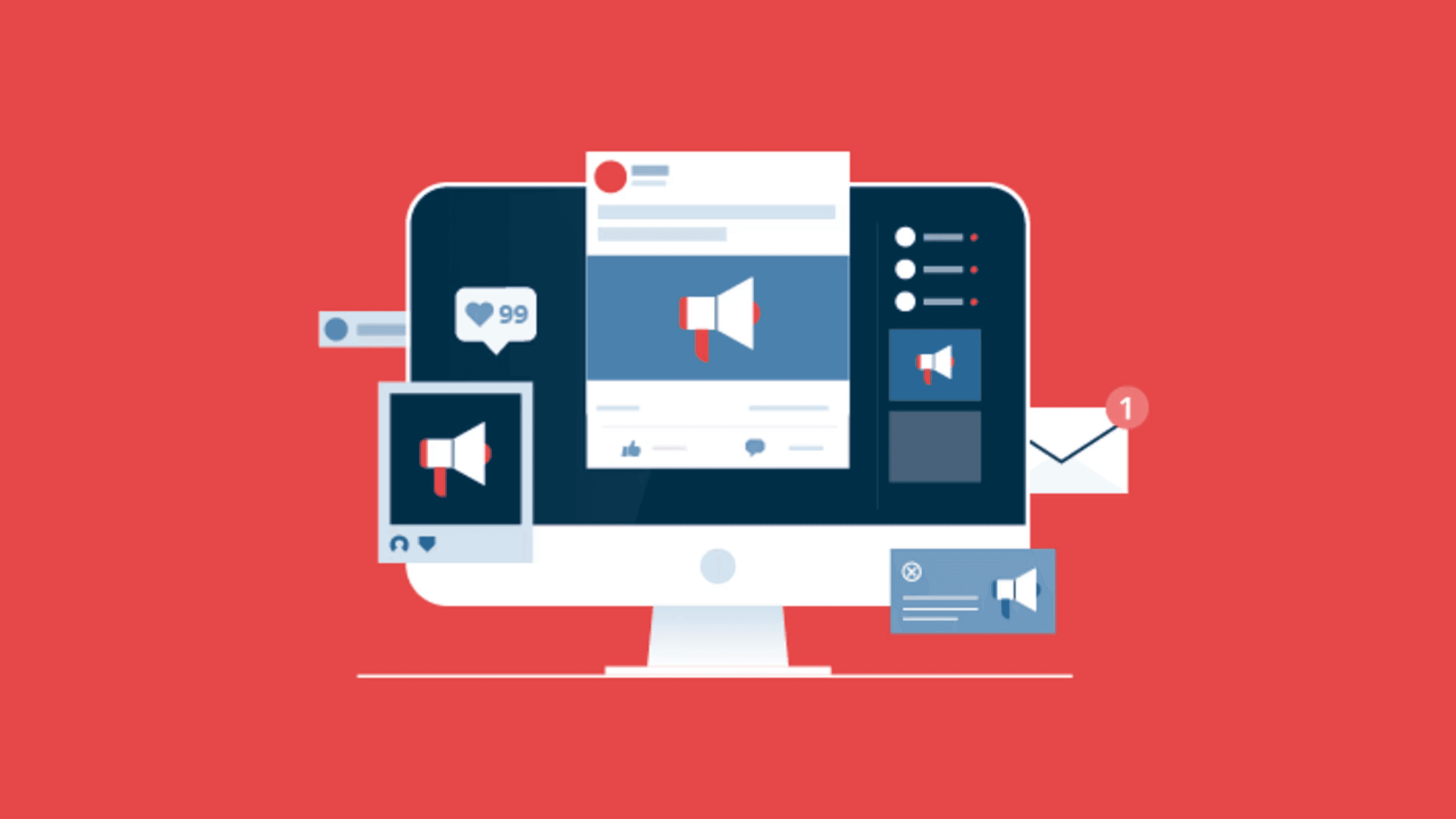
SPF
SPF is an abbreviation of the Sender Policy Framework, which is an email validation system designed to detect email spoofing.
Why was SPF implemented?
Before 2002, when the idea of SPF was brought to public attention and stirred a broad discussion, electronic mail exchange relied on SMTP(Simple Mail Transfer Protocol), with no additional sender address checking. The problem with SMTP is that it does not verify the validity of the sender's address, so the sender can put any email address they want in the "from" section.
This deficiency was frequently taken advantage of by spammers and phishers. Phishers could enter a forged email address in the "from" section and send emails to bank clients, who, not suspecting anything untoward, shared personal bank details. This way, spammers and phishers were hiding their real identity and avoiding responsibility.
How does SPF work?
SPF allows the users to specify which computers are authorized to send emails from the domain name they have registered in the DNS. As the "from" section is at the beginning of the SMTP dialog, receivers can verify the SPF record. If the source address in the "from" section is unauthorized, the message gets rejected.
If the email address does not hold any SPF record, it is likely to be caught up in the spamfilters, which improves the general situation with spamming.

Sponsored content
Sponsored content is promotional content created by an advertiser but posted by another publisher, brand, or influencer.
From a user’s point of view, it’s easy to detect paid content because it is marked as “Paid post,” “Includes paid promotion,” “Presented by,” “Sponsored by,” “Partnered with,” “Promoted,” “Affiliated with,” “Powered by,” etc. Let’s find out why companies actively use sponsored content in their digital marketing strategies.
Whyis sponsored content effective?
There are three main reasons why sponsored content is an effective tactic. It’s relevant and authoritative, which means that a good portion of users who engage with a content publisher or influencer will enjoy sponsored content, too. It only works this way when it’s delivered by two brands that operate in neighboring fields and when their target audiences share some common values.
The mechanism that stands behind sponsored content creation is simple. Two brands agree on apartnershipand discuss their conditions. Usually, one brand (an advertiser) creates content and pays another brand, social media influencer, or publisher for sharing it with their audience. Sometimes brands cooperate to create content together and cross-promote it to their subscribers.
Sponsored content is a simple yet effective way to deliver your promotional message to new audiences. Let’s find out which pros and cons this type of content has.
Pros and Cons of Sponsored Content
Sponsored content has the following advantages:
it adds credibility and trustworthiness to your brand image since it is shown alongside other things that a viewer enjoys;
it improves theuser experience rather than interrupting it like regular advertising posts;
it can appear in any format or media, which makes sponsored content quite a flexible strategy;
it is beneficial for both parties since both brands acquire new subscribers from such a collaboration.
Sponsored content has the following cons:
social media platforms and laws in some countries require that it must be stated that content is sponsored, so the corresponding mark may ruin nativity;
some users have negative expectations knowing this content is paid for;
an irrelevant sponsored content campaign may disrupt the user experience, bring some negative feedback, and increase unsubscribe rates, which leads to reputation issues.
Let’s find out the difference between sponsored and branded content types.
Sponsored Content vs. Branded Content
As we already know, sponsored content is a paid advertisement where one brand is a creator, and another one is a publisher. In contrast, branded content is created and distributed by the same brand or at least by different departments of one large company.
Branded content is usually published on brand-owned properties such as blogs, micro-sites, content hubs, forums, etc. Another key difference is that branded content can only be targeted at a brand’s existing audience. It helps increase a brand’s trustworthiness by creating content with a high level of expertise, while sponsored content is a great way to grow your audience.
Let’s find out what sponsored content can look like.
Sponsored Content Ideas
Any type of content you can think of can be sponsored because it isn’t restricted to any format or style. The only thing that separates regular content from sponsored is a sponsorship deal that stays behind the scenes.
Sponsored content can be presented in the following formats:
articles;
listicles (articles with lists of best artists, brands, services, etc.);
videos;
photos;
infographics;
tweets on Twitter;
pins on Pinterest;
Instagram posts, Stories, and IGTV videos;
Facebook posts and Stories;
Snapchat Stories;
YouTube videos and shorts;
podcasts, etc.
As you can see from the list above, sponsored content is mostly used across social media platforms. Each platform allows to deliver this type of content in a different form. That’s why social media feeds are a great fit for sponsored posts.
Let’s get inspired by some great examples of sponsored content.
Examples of Sponsored Content
We’ve collected several examples where companies wisely use sponsored content in their strategy.
Taco Bell Snapchat
Snapchat is a popular image and video sharing platform that has a “filter” feature where users can alter their faces and surroundings. Taco Bell collaborated with Snapchat to create a sponsored filter that went viral and gathered over 224 million views. Aside from the filter, Taco Bell created a series of promotions on Snapchat Stories. Users had a lot of fun with this Taco-face filter as they enjoyed it without being interrupted. Here’s how it looked.
Source: MobileSyrup
Vanguard Shopify
Podcasts continue to gain popularity, and sponsored podcasts are a great way to increase brand awareness if the company that hosts the program is related to your business field.
In this piece of sponsored content, Shopify supported small businesses by raising a discussion about how small companies, subculture representatives, and local communities make money today. People can listen to this podcast on Spotify or Apple Music. It’s promoted by Shopify but is solely created by Vanguard.
UEFA Champions League Heineken
Heineken collaborated with the UEFA Champions League in a series of sponsored Instagram Stories. It allowed the brewery brand to target European football fans and promote Heineken as a go-to beverage when watching UCL matches. Thanks to detailed targeting options, this sponsored content does not interrupt the user experience, and the story (like any Heineken advertisement) is fun and smart.
Source: ActiveCampaign
Congratulations, now you know what sponsored content is, why it is effective for businesses, and in which forms it can appear.

Spam trap
A spam trap is an email address that is owned and used by Internet Service Providers, anti-spam organizations, and blacklist operators to detect and catch spammers. Spam traps don’t belong to a real person or may have been owned by someone at one time but are now abandoned.
Spam traps don’t send emails, have no opens, and don’t give permission to receive emails. Spam is a significant problem for a lot of internet users. According to Statista, spam accounted for 53.5% of the total email traffic in the world as of September 2018. A spam trap is designed to look for everything like a real email address so that it can attract spam and shut down its travel path by blocking the sender's IP address.
Why are spam traps dangerous for email marketers?
A spam trap is exclusively created to receive junk mail, and all messages that it receives are classified as spam. Therefore, if an email is sent to such an address, the sender reputation is negatively affected. The sender consequently gets higher bounce rates and reduced email deliverability. It may also lead to:
Blacklist providers and ISPs can block the IP address.
Email Service Providers can refuse to send one’s emails to protect their customers and business.
Recipient’s ISP can ban one’s emails and blacklist the associated domain.
Anti-spam organizations can share the sender domain with all the ISPs that they work with, which leads to blocking any email from the domain.
How does a spam trap work?
Spam traps are a form of protection system used by ISPs such as Google, Yahoo to safeguard their recipients. They keep email inboxes free from messages that users don’t want and are usually created to trick spammers. Spam traps are also hidden and almost undetectable. The most obvious place to find spam traps is in random email addresses’ lists from the internet.
Spam traps are monitored continuously by ISPs and blacklist providers. Any email sent to them is traced, and the sender is blacklisted. A marketer who doesn’t follow email sending best practices is at higher risk of adding spam traps to their mailing list.
Types of Spam Traps
Spam traps can be classified based on how they were created and the way they operate. There are two basic types of spam traps:
Pristine spam traps. Also known as pure spam traps, these addresses are designed initially to be spam traps and were never a valid email address from the start. They are usually hidden within a public websites’ code. They don’t belong to a real person and can’t agree to receive emails. These spam traps help to catch marketers parsing emails on sites or buying contact lists.
Recycled spam traps. These are addresses that were once valid and owned by real people — and may have even signed up on several websites — but are no longer in use and are invalidated. Their providers can repurpose them and monitor senders. Any sender who continues to send emails is categorized as a spammer.
How to Avoid Spam Trap Email Addresses
If there is one thing that email marketers should know before launching any campaign is how to keep off spam traps. Sending emails to recycled and pristine spam traps can gravely affect businesses’ reputation. Here are two ways to avoid email spam traps with LIKE.TG:
Set up double opt-in subscription forms
Use LIKE.TG to set up customized subscription forms with double opt-in function. When a visitor subscribes, an email with a link is sent to them to confirm their subscription. So, if the new subscriber doesn’t confirm their subscription, their address is not added to the mailing list.
Verify your mailing list
Email verification is a must if you haven't sent emails in a long time, collected addresses using single opt-in, or added them manually to your mailing list. Verify them with our tool to remove outdated and invalid addresses and increase your email deliverability. You can check up to 100 emails each month for free.
Clean up mailing lists regularly
Mailing list hygiene is essential since your base may contain the email addresses of clients who made a purchase three years ago and are no longer interested. To check your mailing list quality, send a reactivation email campaign to passive subscribers. If they don’t interact, remove them from the mailing list. This way, you will deal only with the engaged audience.
So, if youfollow the best practices while sending email campaigns, your mailing list will be safe from spam traps.

Spamhaus
Spamhaus is a non-profit organization established by Steve Lindford in 1998. Spamhaus tracks email spammers and spam-like activity. The name is a pseudo-German word used to signify an organization, which works with spammer activity.
Spamhaus is comprised of several companies, which run anti-spam activity in different aspects of the Spamhaus anti-spam technology.
The organization is responsible for creating several big lists of spammers, which are widely used by ISPsand email servers to reduce the amount of unsolicited mail in their users' mailboxes.
Spamhaus distributes the lists as DNS-based Blocklists and Whitelists. Small email servers can use these lists free of charge, while more significant commercial organizations, which have many queries, have to sign up for the Datafeed Service.
Spamhaus's Spammer Lists Include
Spamhaus Block List – a list of known "verified" spammers
Exploits Block List – the list of open proxies, which are used to send out spam
Policy Block List – both dynamic and static IP addresses, such as ISP's core routers, which are required by their policy to send mail through third-party servers
Domain Block List – a list of well-known spammers and spam gangs, as well as websites, which are related to phishing, virus, and malware spreading
Botnet Controller List – Spamhaus believes that cyber criminals control these IP addresses
Spamhaus Whitelists Include
Spamhaus White List – a list of verified IPv4 and IPv6 addresses with good reputations. Such addresses have to comply with the strict rules of Spamhaus
Domain White List – this white list of domain names implies automatic certification of domains with DKIMsignatures

Social media strategy
A social media strategy is a well-thought-out plan that indicates when, how, and what content to share on multiple socials of a brand. It helps you use resources efficiently and reach your target audience.
In this video, Alex, a LIKE.TG marketer, shares valuable insights on how to boost your social media strategy with chatbots.
This article will uncover 14 reasons to create a strategy for social platforms and what you should do to develop it successfully.
14 Reasons Why You Need a Social Media Strategy
According to statistics, around 4.62 billion people worldwide are social media users. Although the initial purpose of Instagram, Facebook, and Twitter was to provide communication, it’s no longer their main goal. Oberlo’s marketers emphasize the three main reasons users spend time on social networks: exploring news and trends, finding things to do, and products to purchase.
Since many customers use social platforms every day, you need to build a strategy for each social network. Establishing a brand from scratch on social media without a well-thought-out strategy can be challenging and require excessive expenditures. In this section, we’ll review the main reasons for you to consider developing a strategy. It will help you
establish a strong online presence;
expand your reach;
increase the base of leads and customers;
use resources efficiently;
save time and money;
target your audience with personalized offers;
increase engagement;
provide users with relevant content;
get a competitive advantage;
stand out from the competition;
attract new consumers with influencer’s help;
build a positive brand reputation;
gain brand recognition;
earn customer loyalty.
Now that you have enough arguments to work on your tactics, it’s time to dive into the steps. The next section will guide you through the process of developing your detailed plan for social media and help you do everything right.
10 Steps to Create a Social Media Strategy
Define your goals
Research your target audience
Conduct competitive analysis
Run social media audit
Develop a social media content calendar
Create engaging content
Leverage social media management software
Provide support with chatbots
Use advertising to expand the reach
Analyze social media metrics and adjust your strategy
A gut feeling doesn’t work with social media. To achieve success, you need to develop the tactics of what, when, and how to do to generate interest, build communities, and encourage purchases. A social media strategy is your guide of actions in the world of social users. In this section, we’ll unveil the steps you should take to reach your business purpose on social networks.
1. Define your goals
If you want to develop a winning strategy, determine your primary objectives. Together with metrics, they will help you evaluate the success of your strategy. Use the SMART (specific, measurable, attainable, relevant, and timely) framework to set your objectives. For example, we will use a chatbot for Instagram to reduce the response time of our customer support on this platform in two months.
Besides goals, you need to identify valuable metrics and monitor them to see the progress of your strategy. At this stage, likes and followers don’t bring real value. The metrics you should track depend on your key goals. For instance, if you use Instagram to boost traffic to your site, track click-throughs from your bio link, ads, and stories.
2. Research your target audience
Before creating an offer, you should understand your audience and know what they want to see on socials. After researching your target market, create a buyer persona to understand your audience and target them with personalized offers. To develop a detailed persona, you should identify their age, interests, location, income, occupation, preferred social media channels, etc.
Remember, followers on your social media accounts are your potential customers, so treat them accordingly. Explore their needs and desires to find out how to approach and engage them. Social networks like Instagram have an Insights tab that allows you to obtain helpful information about your followers: their gender, age, location, interaction with your company, and more.
Below you can see an example of Instagram Insights.
3. Conduct competitive analysis
Since 58.4% of the world population now uses social platforms, the odds are that your rivals already have profiles on Instagram, Facebook, and Twitter. So you should create appealing profiles to attract followers. Your competitors will help you develop a successful strategy. To take advantage of your rivals, conduct a competitor analysisto reveal their strengths and weaknesses.
By examining the social accounts of your rivals, you can find your biggest competitors, uncover the platforms they use, and the content they create and assess the level of customer engagement. With analysis, you’ll be able to identify the best time for publishing, find new marketing approaches, get inspired to create engaging pieces of content, explore trends and topics, and unveil the pain points of your target market. After you research, you can identify the gaps. Eliminate these problems as soon as possible.
4. Run social media audit
A social media audit is the process of a business reviewing its key metrics to assess the performance of its social media strategy. The audit covers every social media channel and environment, sentiment, challenges, and opportunities for each of them. Once you finish the audit, you’ll understand the desires of your target audience. You’ll be able to identify the most successful platforms, determine a content schedule, and figure out the most appealing type of content for your brand. As a result, you’ll focus on the alterations to your strategy, which lead toward the achievement of your initial business goals.
If you already have accounts on social networks, you need to evaluate your efforts so far. Analyze everything you have done for your social media since you created accounts: the strengths and weaknesses, people who like to engage with your brand, the channels they prefer the most, and your social media performance compared to competitors. After doing an audit, you’ll find out the purpose of each account. Yet if the channel’s purpose isn’t clear, consider revising or transforming it.
Below you can see a social media audit example. It covers elements you should include.
5. Develop a social media content calendar
Social media calendar is an outline of your upcoming publishings on socials, organized by date. You can create a calendar manually with a spreadsheet or leverage a special tool. To share posts on time, your content calendar should have the date and time of publishing, the platforms you want to add the content to, creative assets, and useful links.
Social media calendar enables your team to save time, provide users with consistent content, reduce mistakes, and improve content quality. Besides, when all team members have access to the spreadsheet or a management tool, they can proofread the posts and avoid typos.
Below you can see a HubSpot calendar template.
This is what a content calendar looks like if you decide to choose a specific management platform.
6. Create engaging content
Having a huge social media audience doesn’t guarantee your business' success. If you struggle to generate the interest of your target audience and gain attention on socials, you should create engaging content. Instagram is a perfect platform for interaction with your followers. Consider implementing engaging ways to communicate with your audience. Create polls for Instagram Stories, use specific hashtags, ask followers about their experience and opinion, provide customer stories, and share valuable data in carousel posts. Besides, ask followers what sort of information they would like to see next, implement QA time, and provide some games.
Make use of the most successful Instagram format reels — 15-second multi-clip videos with audio. You can share useful tips, lifehacks, effective platforms, and step-by-step guides. People will love them and like, comment, and share.
Below you can see Lavazza inviting followers to play the well-known “Bingo” game to increase engagement and reactions.
According to statistics, users are 35% more likely to sign up after seeing original pictures of a brand. That’s why consider making your own photos and videos instead of using stock materials. Besides, you can hire a professional who will create brilliant branded graphics for your socials or use a web-based platform to design it on your own.
Every marketer will recognize Neil Patel and his brand. In the video below, Neil Patel explains how to use Google ads.
Consider including customer testimonials on your social media. Testimonials help establish trusting relationships with customers and build a positive brand image. 79% of consumers trust customer reviews as much as friends’ recommendations.
Below you can see how Club Life Design shares reviews of its digital product. The brand includes all customer testimonials in Instagram Highlights.
7. Leverage social media management software
Social media management tools empower you to handle several social media from one place, build relationships with followers, and develop an editorial calendar to publish posts on time. In addition to increased engagement, such platforms enable you to track and analyze social performance.
Whether you have a startup, a family company, or a large enterprise, you can find a tool for any business size. Social media managers are often overwhelmed with the social media tasks they need to complete every day. Hopefully, you can consider many platforms to keep an eye on the processes like content creation, scheduling, and tracking performance. Hootsuite, Buffer, Sprout Social, and Agorapulse allow you to manage multiple socials from one place, which is extremely convenient and time-efficient.
8. Provide support with chatbots
According to statistics, bot-only chats receive an 87.58% satisfaction rate. Chatbots imitate human conversation and allow your company to provide 24/7 support. Once social media users have inquiries, they can send you a direct message and receive an instant autoreply on common questions.
You can employ chatbots for the biggest social networks like Instagram, Facebook, and Twitter to provide users with instant information. For instance, accounts of online shops on Instagram incorporate chatbots to give real-time responses to people’s questions. They use quick-reply buttons like “prices,” “available items,” “sizes,” “delivery,” etc. As a result, they immediately receive answers to their questions.
If you are interested in making the work of your customer support agents more efficient and reducing the workload, consider using a chatbot builder. With LIKE.TG’s chatbots, you can set up auto-replies to answer FAQs, move prospects down the sales funnel, send personalized messages and reminders, gather customer feedback, and respond to brand mentions on Instagram and Facebook.
Below you can see an example of a chatbot created with LIKE.TG.
9. Use advertising to expand the reach
Instagram is home to 1.47 billion active users who spend around 29 minutes daily on the platform. This time is enough to communicate with friends, explore trending, and search for products. Yet brands still search for the best places for their ads. Companies should run ads on social media to expand their reach, generate new leads, drive traffic to their websites, and increase sales volume and revenues.
Use paid advertising to present your product to potential clients and build awareness. If you succeed in capturing attention, users will follow the link and visit your profile or website. After exploring your content and product features, they will make a decision. You can apply different types of advertising based on your main business purpose. Social media platforms offer you to make use of photo ads, video ads, and stories ads. You have the option to run campaigns manually or use Facebook Business Suite, AdEspresso, Hootsuite, or Revealbot.
Retargeting helps you target people who have already visited your site or social media accounts. It ensures more touchpoints with prospective customers, boosts conversions and sales, and encourages brand recognition. Sponsored content is a type of promotional advertising that involves a sponsor (company) paying a publisher (influencer, opinion leader, industry expert, or marketing agency) for promoting a brand on social media platforms. It helps showcase your product, expand your reach, increase your following, and drive sales.
Below you can see an example of Thinkific’s sponsored ad on Facebook. This advertising targets users who show interest in the product.
10. Analyze social media metrics and adjust your strategy
Creating a profitable social media strategy is challenging, so it can’t be perfect on the first try. However, you can always improve it. To do it, look at the performance metrics to see what’s missing in your strategy. Pay attention to reach, engagement, impressions, conversions, referrals, and response rate. Besides these metrics, you can also track UTM parameters (short text codes linked to your URLs). Parameters show the value of social media campaigns, provide information about traffic and conversions, and measure ROI.
Use this data to improve your strategy. For instance, change the frequency of posts, implement storytelling, or add customer testimonials to communicate your value. Test different options to find the most effective strategy for your business. Leverage a special social management service to check the performance of each platform. Assign this task to a certain person to do it every day and have a clear picture of moving towards goals.
Now you know what social media strategy is and why it’s crucial. Hopefully, our ideas and examples inspired you to do everything in your power to work out an effective strategy.

Spam filter
A spam filteris a program designed to protect users from spam,and it is used to filter incoming emails or links.
The spam filter uses ready-made lists with undesired addressees or website addresses. Accordingly, these lists must be created. To make the spam filter work more efficiently, it must be "trained." During the "training," the spam filter specifies the criteria by which the letters will be sent to spam. It is also necessary to mark "non-spam" emails so that the filter can catch the difference between personal messages and spam. Often, while producing mass mailings of your emails, you unwillingly become a spammer. This is because you do not follow the rules of mailing.
Spam Includes
Announcements of winning significant sums of money;
The question "Why should you pay more? "
A money-back guarantee;
Information on an urgent matter;
Offering cheap mortgages or refinancing;
The opening of the secret of instant success.
Rules to Follow
Do not use the phrase "Win a million!" "Advertising!" and other spam-like phrases;
Do not use a lot of "CAPS LOCK" and exclamation marks in the subject lines;
Do not select all the text of the letter in bright colors;
Check the correspondence of the HTML part of the message and the text, the correctness of the encoding;
Do not use one image instead of the letter text.

Social proof
Social proof is a social phenomenon in which customers copy the actions of others to achieve the same result. It encompasses testimonials, case studies, reviews, and comments on social media, which companies use to encourage leads to convert into customers. It helps gain trust, attract new clients and drive customer loyalty.
In this article, we’ll uncover the importance and 7 types of social proof. We’ll also teach you how to use social proof in marketing and provide several excellent examples.
Why is social proof important?
When people look through the websites, visit the landing pages, and explore branded hashtags on social media, they hope to see proof that these businesses bring real value. Reviews, testimonials, case studies, comments, and influencer recommendations help brands persuade people that their products and services are solutions to their problems.
After potential customers check the necessary information on the company's landing page, see comments on social media, try demos, and read overall reviews from experts, they are ready to take the desired action. That’s because social proof sways customer decisions in favor of sellers. There are many reasons to have social proof on your website or social media account. Foremost, a business looks trustworthy and a product more useful since it was validated by existing clients.
Having reviews is essential since they help shape a positive image about a specific company and its product, prove that a brand is reliable and that the product has high quality. Besides, customers and industry experts who leave positive feedback and reviews become word-of-mouth promoters. As a result, a company can get new conversions, improve brand recognition, gain brand awareness, and increase its customer base.
Now that you know why social proof is important, let’s proceed to the next section to explore 7 main types.
7 Types of Social Proof
Many different types of social proof enable brands to earn trust, loyalty, and conversion rates. We’ve prepared a list of formats companies use to influence customer decisions. So let’s dive in.
Testimonials. These are short reviews from customers that aim at recommending a product and demonstrating its benefits. Testimonials showcase the company and encourage prospects to purchase because of the product’s value.
Celebrity endorsement. This type implies celebrities or opinion leaders who use products of specific companies and then recommend them to their followers. These promotions can be both paid and unpaid. Unpaid endorsements have a higher value for consumers since influencers promote products for the real value and benefits they bring.
Reviews. Both companies and third-party websites collect customer reviews to share positive experiences with their businesses. They are helpful both for customers and businesses. While clients can make sure that a company is credible, companies can gain trust. Besides, these pieces of feedback enable brands to improve rankings, boost customer loyalty, and increase conversion rates.
Business credentials. Credentials allow brands to gain additional trust from consumers. By making the number of customers, certifications, awards, and famous clients public, companies can hook the audience's attention and encourage them to use their products. This information will signify that many people use a brand, well-established companies approve of it, and it also has all the necessary knowledge, technologies, and experts.
Shares on social media. According to statistics, 78% of clients are ready to purchase with a brand after having a positive social media experience. Since 4.62 billion people now use social media, being active on social networks is a must for businesses. If you have informative posts on Instagram, Twitter, or Facebook, people might like to share information about your company and promote your product for free.
Media. If the media mentions your company as an outstanding one, it'll positively impact brand awareness and recognition. These mentions show that your brand is worthy and reliable.
"Wisdom of the Crowds." This type of social proof includes a fear of missing out. Many customers wish to purchase products from a specific company, and others assume that these products are good and a brand is trustworthy. As a result, they purchase them too.
The types are clear, so it’s time to figure out how to use social proof in marketing.
How to use social proof in marketing?
Social proof can serve you as an effective marketing approach, and you need to know how to implement it wisely. So explore some tips that will help you with it.
Consider having ambassadors. You can invite an influencer, opinion leader, or industry leader to become brand ambassadors. These people will help you promote your product and prove that your brand is reliable and high-quality. Brand ambassadors will use your product and share their experience with their large following on social media. They will also use the branded hashtag to increase brand engagement.
Encourage user-generated content. Many users share their experiences on social media after they purchase products. Photos, reviews, testimonials, and videos that people post can be a valuable source of information for prospects and generate customer engagement (likes, comments, followers, and shares). If users tag your company and mention your branded hashtag, new people can explore your products and eventually become customers.
Include customer testimonials on your website. It’s an excellent idea to include testimonials on your website and highlights on social media networks. This way, you’ll show leads that many people and companies choose your product because of the quality, price, features, usability, etc. Your current customers can promote your brand and encourage people to take the desired action by sharing their thoughts about your product.
Mention the number of customers on your website. If your company has a large customer base, consider mentioning it on your website. This way, you’ll implement the “wisdom of the crowd” social proof. It’ll influence people’s perception of your company and make a positive first impression. Once consumers see that many people trust and buy from your company, they will think about becoming your customers as well. In addition, you can include the number of countries your company serves and the number of recommendations.
Collaborate with industry experts. To drive positive associations among your followers, you need to invite an expert to take over your social media. This industry expert will create educational materials, live with followers, and upload Stories. It will result in increased trust, engagement, and loyalty.
Now that you know how to use social proof for your business, it's time to delve into some examples.
Examples of Social Proof
You should look through several excellent examples from world-famous brands to figure out the most powerful social proof for your business. We’ll now review different situations in which companies managed to attract the audience's attention with the help of their satisfied customers.
Amazon
Amazon implements the most effective type of social proof — customer reviews. With their help, new visitors can explore the experience people had with a specific product. Potential consumers can read customer feedback and see product photos to find out whether they are satisfied with it. Moreover, users can see product ratings based on the number of stars consumers give.
Zoom
Zoom uses customer testimonials to attract potential customers. Once visitors land on the company’s website, they can scroll down to see testimonials from representatives of famous brands who leverage this communication platform for various needs. As a result, users can have an overall picture of the service and its benefits. For instance, from the testimonial below, you can find out that the platform is easy to work with.
Rare Beauty
Rare Beauty is a relatively new brand in the market of beauty products yet extremely popular among young people. One of the brand’s customers left a review in Instagram posts tagging the Rare Beauty brand. The girl demonstrates the company’s tinted moisturizer and tells the peculiarities of the product that might be helpful for people who consider buying this product.
If you don’t have social proof on your website or social media networks, you can consider doing this step. Customer reviews, testimonials, and tags on Instagram enable potential consumers to make sure that your brand is credible and trustworthy and make a purchasing decision.

Social media optimization
Social media optimization (SMO) is a strategy that involves a company striving to establish an online presence and communicate the main brand’s message through social media. It helps businesses reach their target audiences, improve brand awareness, and establish trusting relationships with consumers.
In this video, Alex, a LIKE.TG marketer, shares valuable insights on how to optimize your social media with chatbots.
In this article, we’ll review the importance and pros of SMO. We’ll also make the difference between SMO and SMM clear, unveil 4 effective strategies and 3 powerful tools.
Why is social media optimization important?
Many companies switch to modern social networking services like TikTok, Instagram, and Twitter to communicate with customers and hook their attention. SMO aims at driving awareness and traffic to your website. It’s a powerful tool for establishing your brand’s online presence and becoming an authoritative company. With its help, you’ll be able to establish positive branding, enhance brand recognition, visibility, engagement, and awareness.
You can create videos, photos, ads, and blog posts to communicate with more potential and existing customers. Clients can interact with your brand by using their most convenient mediums. They can see your ads on Instagram and land on your website. The strategy enables you to present your product to new geographics, which results in a wider customer base. This way, your website traffic will increase. If your company’s team works properly both on SMO and SEO, you can obtain a better ranking on search engines.
Besides, social platforms are now widely used for lead generation. Your campaigns and ads will help attract prospects and encourage them to make purchasing decisions.
Let’s now explore all the benefits of SMO.
Benefits of Social Media Optimization
Optimization of social networking services is a must for any company that seeks growth. Although the process needs your time and effort, you’ll be happy to see the results after the successful implementation. These are the benefits you can reap:
more loyal customers;
better customer service;
higher brand visibility;
strong online presence;
active customer interaction;
improved brand awareness;
higher customer engagement;
wider reach;
more leads;
website traffic;
higher ROI.
Now you know the possible advantages you can obtain once you work on social media optimization, so it’s time to find the difference between SMO and SMM.
SMO vs SMM
People often confuse these terms because they have similar goals. To avoid any misinterpretation, we’ll unveil the main distinguishing features of SMM and SMO.
SMM is a type of marketing that implies the use of social networks to promote products, increase customer base, boost traffic, and improve sales. Social media marketing encompasses the processes outside the company’s website. Once you optimize your website, you proceed to the next step — promoting your product off-site. Companies create content and develop strategies to effectively communicate it to the audience and interest potential customers. You can convey brand messages in various forms such as blogs, ads, images, and videos, and they will tell about your product to a wide audience.
SMO is a process of optimizing a company’s website so that it can be shared on different social media networks. It’s about on-site optimization. Business owners make their sites look more compelling and improve usability to attract customers to their accounts on platforms like YouTube, TikTok, Facebook, and many more.
Simply put, SMO is about on-site optimization, while SMM encompasses activities outside a company’s site and involves creating ads, posts, campaigns, and articles to disseminate information about a specific product.
4 Effective Social Media Optimization Strategies
You should implement different techniques to improve your website for social media platforms. We’ve listed the most effective strategies so that you can consider them for your company.
Optimize your content for different networks. You should use the specific content format for each of the social media channels. For example, TikTok requires you to create short videos, while Facebook allows you to publish sponsored ads. Besides, before creating any type of post, ad, or video, you need to define goals for each network and develop a strategy. The strategy should cover your target audience and industry. You also need to analyze the performance of your previous posts and optimize them.
Consider using external links. If you aim at boosting your website traffic, you should pay attention to link building. There’s a point in adding external links to your articles. This will help you increase the chances of being noticed by search engines. Moreover, it will influence the visibility of your company’s site and enhance the number of visitors.
Include social media plugins on your site. Many people who like your post can share it on different social media platforms from their accounts. However, many websites don’t provide such functions, making it impossible to share. If you want your website to become visible on social media and obtain more customers, you should add social media plugins to your site. As a result, users will be able to share your content with a click of a button, and you’ll get updated on the number of shares.
Use hashtags. Hashtags boost brand engagement. By putting hashtags under your posts, you increase the chances of being noticed by the target audience. People can easily find the necessary information by simply inserting the hashtag into the search field. They can also explore the related articles.
Let’s now explore some useful SMO tools.
3 Social Media Optimization Tools
More and more companies get involved in SMO because it helps hit their main objectives. Since it’s an effort-consuming process, it requires automatization. Hopefully, many outstanding platforms can help you manage your social media networks and provide you with features for publishing and monitoring your performance. Now let’s delve into the best tools worth your attention.
Agorapulse
Agorapulse offers several features to manage your Instagram, TikTok, Facebook, or other platforms. The service allows you to handle all incoming messages in one place. With this service, you can also optimize content and schedule the date and time to publish it. Its listening tool updates you on people’s opinion on your company and competitors’. Finally, you can leverage the monitoring function, which provides you with reports. In these reports, you can find information about the things that work and don’t work within your social media.
You can start a 15-day free trial to test the features of a plan you are interested in. Once you decide that it’s a perfect fit, you can purchase a paid plan for a small team that costs $99 per month. However, if you have a big team, consider buying a premium plan with a monthly fee of $199.
Buffer
Buffer provides different social management tools such as publishing, analytics, engagement, and start page. The platform offers you to keep an eye on the performance of your social media channels and figure out what content people want to see. Once you finish with analytics, you can jump into the next stage and work with your team to create content and schedule the date of publishing. With Buffer, you can track your customers’ comments and respond to them fast from one place. Later, you can see analytics to assess your progress.
The service is perfect for beginners since it has a free plan. So if you are just starting, go ahead and register. If you are a professional who needs engagement, analytics, and publishing tools, you’ll need to pay $6 per month for each channel you use.
PromoRepublic
PromoRepublic is a leading service that enables you to manage different social channels from one platform. With its help, you can create and publish content at the right time, communicate with users, and monitor results. Besides, you can share your content with partners to represent your company. If you want to explore pricing, you need to directly contact PromoRepublic’s sales team and calculate the price.
Congrats, now you know the reasons why so many brands implement SMO. If you consider developing this strategy, make use of the tools above to simplify the process and keep an eye on the performance of your campaigns.

Spammer
A spammer is a person who sendsspam.
Many people mistakenly consider sending bulk emails as spam, but it is not the case. An email is spam in only one case — if the recipient has not given their permission to receive emails.
Why is it called spam?
The word spam refers to canned food. It is cooked meat, placed in a can. It was widespread during World War II when there was not enough meat for the soldiers, and they had to eat canned food every day. Everybody was fed up and annoyed by the SPAM. This abbreviation has several meanings: SPiced hAM, Shoulders of Pork And hAM. The original idea is known only among the founders of the brand.
Spam took its name after this canned food because it is annoying and not of the best quality.
Who was the first spammer?
The first known spammer was Gary Thuerk, a marketer in the Digital Equipment Corporation. He sent the first spam in 1978 to 400 recipients, out of 2600 on ARPAnet. Gary Thuerk sold DEC machines, and actually, his spam worked, as he got $13 million income. Thuerk received some complaints, but his favorite one was from a man from the University of Utah. This man said that he had not managed to use his office computer as the spam email used all the disc space. Gary Thuerk considers himself not as the first spammer, but most email marketers do.
Spam Also Includes:
Advance-fee fraud
This fraud is known all over the world. It is also called Nigerian bank scam, Nigerian money offer, Nigerian Letter, 419 fraud, Nigerian scam. The country it originated from is obvious. Firstly, it was a postal fraud sent between 1970-1980-s during the Second Nigerian Republic. Many of the letters were believed to be written by the members of the royal family, government, and people in the business. They asked for financial aid, in particular, bank account numbers. They pretended to need help because of currency devaluation in the country. Then, it became a widespread email fraud. Spammerssay that they have inherited a fortune, but they need your bank account for transfer, and if you help — you will get the interests. So, people give a fee in advance and receive nothing.
Phishing
Spammers want you to give your personal information at the fake websites that look like the legitimate ones.
Marriage Agency Scam
These spammers pretend to be a marriage agency or a translation agency. They create fake profiles with photos of fictional brides. When a man from abroad becomes interested in a woman, they require money for translations, fees needed for the call, etc.
Word of Mouth
Recipients get an email according to which somebody published a secret about them, and to see it. They should pay a fee.
Lottery Scam
Thisis another popular scam all over the world. People receive an email saying that they have won a lottery, and need to get the money. They should pay the transfer charges. Certainly, they do not receive any money.
CAN-SPAM Actsets the rules for sending commercial emails and establishes the requirements. Also, the punitive measures for violation are specified. Discover more about the CAN-SPAM Act.

SpamСop
SpamСop is a spam reporting service. The platform allows users who received unsolicited or bulk emails to reportIP addresses, identified by the SpamCop analysis as spam senders. These reports are then used by SpamCop to compile the so-called "SpamCop Blacklist."
SpamСop was founded in 1998 by Julian Haight and is positioning itself as an individual effort to contribute to the efforts of stoppingspam. As the service gained popularity, they hired more staff, and the SpamCop Blacklist was extended and became more popular.
The service has seen two acquisitions: one by IronPort Systems in 2003, and the other one in 2007 by Cisco Systems. After the second acquisition, SpamСop's founder Julian Haight left the company.
SpamCop has faced severe DDoS and other kinds of attacks from spammers, and in spite of it, it survived and proved its usefulness. In particular, it proved to be effective in helping IPSs, web hosts, and email providers to identify abusing accounts before the spammer had finished the process.

Spam email
Spam email, AKA junk email, is an email sent without explicit consent from the recipient. Spam emails usually try to sell questionable goods or are downright deceitful. This is the dark side of email marketing. Since the 1990s, spam email has been becoming a more advanced phenomenon in terms of its outreach and the technical solutions for bypassing restrictions.
In this video, Alex shares valuable tips on how to avoid your email from landing in the spam folder. Check it out!
What is the purpose of spam email?
The main idea of spam is to make a profit. Mass email sending is cheap and easy compared to physical mail. Near 250 billion emails are sent globally every day, and 45% of them are spam. Even though the conversion rate is shallow — one replyin 12,500,00 spam emails sent, according to TechRadar — it is still worth a spammer's while.
In most cases, spammers disguise unwanted emailswith the mask of promotions offering something from the “ultimate diet drug” to “100% working remedy for men’s health”. Aside from commercials, the most popular types of spam include adult content and emails promising financial independence by following simple instructions.
According to the Register of Known Spam Operations (ROKSO), most of the world’s spam activitycomes from about a hundred of so-called “spam gangs” operating mainly from the USA, Russia, and China.
Why do I get spam emails?
Your email address was exposed during a data leakage
Your email was harvested by a specialized tool
Your email was stolen from someone’s contact list
Your email was randomly generated
A dishonest company sold your email
Your email address was exposed during a data leakage.This is the main reason behind spam email spreading, which happens even to the large organizations like Adobe, LinkedIn, Last.FM. It is a security threat because it may include names, passwords, and email addresses. Spammers use this data for illegal activities knowing that the majority of emails are active.
Your email was harvested by a specialized tool. If you ever published your email address on the internet, spammers may steal it using tools for crawling the internet for an @ symbol, which is mostly used at the beginning of the email domain — for example, [email protected].
Your email was stolen from someone’s contact list. If spammers figure out an email address and password of your friend, they scan the contact list to get new addresses and send more spam.
Your email was randomly generated. Cybercriminals combine common user names with popular domain names like @gmail.com or @yahoo.com. They send spam emails to all generated email addresses, and if the email was delivered and opened, it signals that the email address is real.
A dishonest company sold your email. Some dirty players on the email market sell their mailing list to spammers.
Spam vs. Phishing
Phishing is an advanced type of spam email. Thieves disguise themselves as well-known brands with an excellent reputation to get sensitive data like users’ names, passwords, credit cards, bank account, etc. They usually frighten or excite users leading them to a fake website where the cheated people for their money.
Meanwhile, spam is a mass copy sent to many people at once, mainly in an attempt to sell dubious products like revolutionary remedies, get-rich-quick schemes, etc. It is not as sophisticated as phishing, and it doesn’t require a rich technical background.
How do I stop spam email?
Mark suspicious emails as spam
Never publish your email address on websites
Do not open spam emails
Do not give an email address to unknown companies
Customize ESP’s filters
Though email service providers like Gmail, Outlook, Yahoo, etc. are armed with spam filters to ensure your safety, it might be not enough, so here’s what you can do to reduce spam:
Mark suspicious emails as spam. By doing so, you avoid interacting with dangerous emails. At the same time, you tell the spam filters that emails like the one you marked as spam are unsolicited. Further emails from that sender will automatically land inyour spam folder.
Never publish your email address on websites. It is effortless to find email addresses on the internet. Simply googling “gmail.com.” may be enough to find thousands of addresses.
Do not open spam emails. When you open a spam email, which you shouldn’t do, spammers realize that the address is valid. Expect more spam in your inbox.
Do not give an email address to unknown companies. Sharing your data with strangers is a bad idea since the least they can do is selling their mailing list to spammers.
Customize ESP’s filters. Create your filters to block messages that include particular words or phrases, limit the size of the incoming messages, block specific domain addresses, or emails with the attachments. Here’s how to do it in Gmail.
Are there any spam laws?
The attitude towards spamming differs from country to country. Let’s check out the most popular laws introduced to fight against spam by country:
United States
CAN-SPAM Act
The United Kingdom
Privacy and Electronic Communications Regulations
Australia
Spam Act of 2003
European Union
Privacy and Electronic Communications Directive
What does the law require legitimate email senders? CAN-SPAM act, for instance, demands companies to useopt-into add users, add visible and working opt-out mechanism in each email, use subject lines relevant to the content inside of an email, and show a legitimate physical address of the sender’s company.
Despite the existing laws against spam, the United States holds the first place in regards to the number of spam email operations. According to Statista, more than 30% of spam comes from the USA or China.
How to stop my emails from being marked as spam?
Take care of your sender reputation
Use proper authentication instruments
Check emails for spam
Work on having a high open-rate
Make relevant content
Opt-in users
Use a reliable bulk email service
If you send bulk emails to promote your business, the spam box is the worst place for your email. Follow these best practices to stay away from spam filters:
Take care of your sender reputation. Sender reputation is a score assigned to a sender based on the quality of email campaigns, their frequency, volume, and user interaction. Avoid sending too many emails or too often because it gives a negative signal to ESP filters, and your future emails will be considered spam.
Use proper authentication instruments. Make sure the bulk email service you use passes authentication correctly with DKIM and SPF checks. LIKE.TG provides users with a reliable SMTP server ensuring your emails will get to the subscribers’ inbox.
Check emails for spam. Use email spam checkers — tools that enable you to predict the reaction of most popular ESPs to your email, get feedback about it, and make changes before actually sending.
Work on having a high open-rate. A subject line mainly forms the open rate, so make it engaging, intriguing, and what’s more critical — relevant to the content of the email. Email campaigns with a high open-rate indicate that subscribers like your emails, which ensures excellent email deliverability.
Make relevant content. Send relevant newsletters and promotions with the help of personalization and segmentation. Divide your audience into groups with something in common like age, gender, location, and add more value to your emails.
Opt-in users. The law requires to send email only to users who willingly provided you with their email addresses. Use a double opt-in method to ensure the subscribers are engaged people who will less likely mark your email as spam.
Use a reliable bulk email service. Usually, when sending bulk emails with your servers, you have to take care of managing the infrastructure and the reputation of your server. Bulk email providertakes this grunt work from you. LIKE.TG sure does!
If you want to be an email sender with a high reputation, read this blog article and learn how to prevent landing in spam.

SpamAssassin
Developed by Apache Software Foundation, SpamAssassin is a Pearl-based email spam-filtering computer program, which can be used as an independent spamfiltering application or a subordinate program to other spam filtering programs.
Ways to Work with SpamAssassin
Integratethe program into a mail server so it will fulfill the automatic filtering of mail sent to the website.
Integrate with several email clientsto be run by individual users.
Spam-filtering Methods of SpamAssassin
DNS-based blackhole lists and DNS-based whitelists
Fuzzy-checksum-based spam detection filters
Hashcash email stamps based on proof-of-work
Sender Policy FrameworkandDomain Keys Identified Mail
URI blacklistswhich are tracking spam websites
SpamAssassin applies a variety of rules that are used to detect whether mail is spam or not. In the program's documentation, these rules are called "tests." Each test has a particular value, which will be assigned to a message if it matches the criteria. The value can be negative or positive. A positive value means that the message is "spam" and a negative value stands for non-spam.
By combining all the test scores, the program compiles a general score. SpamAssassin sets the score threshold, which defines whether the message is spam or not. Usually, a message has to match multiple tests to be classified as spam. One only test match will not mark it as spam.
SpamAssassin is free software, also called open source.

Social media marketing
Social Media Marketing (SMM) is marketing that targets social platforms like Facebook, Instagram, TikTok for brand promotion, target audience growth, driving website traffic, and increasing sales.
In this video, Alex shares valuable insights on how to boost your social media with chatbots.
Below you can see thenumber of monthly users of the most popular social platforms.
Social networks
Active users, monthly
Facebook
2.37 billion
Instagram
over 1 billion
TikTok
800 million
Twitter
326 million
LinkedIn
303 million
Pinterest
300 million
Why is social media marketing important for every business?
SMM is the easiest way to reach an enormous audience— nowadays a half of the global population, 3.8 billion people, use social media. Moreover, this number is constantly growing—since 2019, social media use has grown by 9.2%.
Social media is extremely useful for increasing brand awareness. According to Hootsuite, 52% of online brand discovery happens in public social feeds. In other words, the majority of people learn about new brands on social networks.
In 2019, people spent an average of 2 hours and 24 minutes every day. And this indicator has also grown— time spent on social media increased by 1.4%. That makes social media a great way to not only reach your audience but also to interact with them for a long time.
Every year, social networks become more and more significant in terms of boosting sales. For instance, in 2019, 43% of internet users used social media when researching products before making a purchase. Although only 12% of people are ready to click a “buy” button on Facebook or Instagram, social networks are highly significant in the early stages of the buyer's journey.
Benefits of Social Media Marketing
Increase brand awareness
Boost website traffic
Faster and easier content distribution
Regular interaction with the target audience
Industry, marketplace and competitor insights
In addition to access to a broad audience and close interaction with customers, SMM has other advantages. Here are several benefits of incorporating social media into your marketing strategy.
Increase brand awareness
54% of users research products through social media. So, a brand should have high-quality accounts on different social networks to take advantage of the users’ social media interests. In this case, potential customers can reach a brand on their favorite platform. Furthermore, excellent service through social media is also crucial. People expect companies to help them, and, if the assistance was excellent, they are happy to recommend the brand to others —71% of users will recommend a company if they had a positive experience with a company on social media.
Boost website traffic
Although many social media platforms allow brands to sell their products without going to an external website or landing page, social media is still a great way to increase the traffic. For instance, 11% of all mobile website traffic originates from social media.
Faster and easier content distribution
If you promote your business via content marketing, you can distribute your content more effectively with SMM. People always share useful, exciting, and entertaining information with their friends on social networks. It often moves beyond one network and its members and facilitating the growth of your target audience.
SMM is a great way to inform your customers about special offers. Social networks help deliver information about sales or giveaway swiftly and cheaply, although the majority of users prefer to receive promotional messages by email. To meet their preference, give LIKE.TG a try and launch an email campaign.
Regular interaction with the target audience
Because half of the world’s population uses social networks for almost three hours each day, SMM is the best way to interact with the audience. This way, your brand is already in the place your customers prefer to spend their time, so it helps you stay close and be more trustworthy.
Moreover, SMM— more than any other marketing channel — helps you get feedback from customers. In any possible way— through reviews, likes, comments, etc. If your clients have had a bad experience with your product, they would rather inform you about it through social networks, than through email or telephone call. It creates the opportunity to react properly, and retain this particular client and attract others.
Industry, marketplace and competitor insights
Social media gives you a great opportunity to monitor not only your customer satisfaction but also the latest industry trends and your competitors’ activities. With the last industry news, you get the additional content— you can use them as topics to discuss with your followers.
By obtaining data from your competitors, you get the inspiration to improve your product or your approach to SMM— never stop learning from those around you.
Social Media Marketing Goals
You can pursue a huge variety of goals with social media marketing — it depends on your overall marketing strategy. Here are some examples of popular goals for SMM:
community engagement increase;
sales and lead generation;
customer retention;
website traffic growth;
audience growth;
handling negative feedback;
feedback search;
competitors and trends monitoring;
increasing brand awareness;
consumer demand research.
No matter what your goals are, you have to define them precisely— it will help create your SMM strategy and content.
Social Media Marketing Tools
Ten years ago, social networks were a small field, and it was easy for marketers to manage them manually. Today promoting your brand via social media is a tough job, which demands a lot of additional tools to make everything work.
Implements for social media marketing can be used for these purposes:
mentions monitoring;
posts creation and scheduling;
brand-user communication;
performance analytics.
To find more info about useful SMM instruments, their implementation, key features, and pricing, check out our list of 10+ Best Social Media Marketing Tools for 2020.
Social Media Marketing KPIs
Engagement metrics
Reach metrics
Conversion metrics
KPIs or Key Performance Indicators are crucial for marketing, sales, and SMM as well. They are measurable values that will help you understand how successful your marketing is in terms of achieving its goals and overall performance.
However, 19% of marketers in 2019 didn't know how to measure their SMM’s effectiveness. Measuring social media marketing effectiveness has gone far beyond counting the number of likes, shares, comments, and followers. Today it is possible to figure out how exactly your efforts in SMM affect your business.
To make it easier, let’s divide SMM KPIs into several groups according to the specific goals they measure: engagement, outreach, and conversions.
Engagement metrics
In addition to likes, shares, and comment statistics available on every social media channel, you can combine them with some more intricate metrics to get the full story.
Average engagement rate— allows you to monitor the way users interact with your campaigns.
Amplification rate— shows how your followers share your content with others.
Virality rate— helps you understand which of your content has the potential to go viral.
The table below contains formulas to calculate engagement metrics.
Metrics
Formula
Average engagement rate
(Likes+Comments+Shares) / Followers * 100
Amplification rate
Shares / Followers * 100
Virality rate
Shares / Impressions * 100
Reach metrics
These metrics help you understand how many people outside of your followers can see your content.
Post outreach— shows how many people have seen your post since it was published.
Audience growth rate— helps track the speed of your page’s growth in terms of followers.
Social share of voice (SSoV)— shows how many times people mentioned your brand in comparison to your competitors.
Follow the table below to calculate the reach metrics.
Metrics
Formula
Post outreach
Post views / Total followers * 100
Audience growth rate
New followers / Total followers * 100
Social share of voice
Your mentions / All other mentions * 100
Conversion metrics
Your content might be engaging and shareable, but what contribution does it make to your business? Conversion metrics can show you.
Conversion rate— helps you understand how many people converted into customers after your post.
Click-through rate (CTR)— shows how many people reacted to your CTA.
Formulas for conversion metrics are given in the table below.
Metrics
Formula
Conversion rate
Conversions / Clicks * 100
Click-through rate (CTR)
Clicks/ Impressions* 100
How can I create a social media marketing strategy?
It’s impossible to do effective marketing on social networks without a well-produced social media strategy. We’ve already published a precise guide on how to create a content marketing strategy to promote your brand. Here we’ll just sum up the main points:
Determine your goals for social media. Align your SMM goals with the overall goals of your business.
Analyze the target audience of your brand. You have to define your customer persona to reach their hearts. Learn how to work with your target audience on social media.
Choose key social media platforms. Not all of them may suit your business, use platforms that are popular with your target demographic.
Choose your brand’s tone of voice. The way that you interact with customers defines how they perceive your business.
Create an SMM content plan. Include several types of content, namely promotional, entertaining, and informative.
Define KPIs to measure your success. They should strongly correlate with the initial goals of your social media marketing efforts.
How to integrate a chatbot into your social media strategy
How to create and use a Facebook Messenger chatbot with LIKE.TG
How to create and use a Telegram chatbot with LIKE.TG
How to create and use an Instagram chatbot with LIKE.TG
Social media is great for interacting with customers around the clock. Moreover, at least half of your clients expect your business to be open and ready to help 24/7. The only way to satisfy this need without using extra budget resources is to integrate chatbots into your social media platforms.
The finance, healthcare, education, travel, and real estate industries benefit the most from using chatbots. In fact, the usage of them is beneficial for any business, which specializes in customer care rather than sales, and requires customer support or other types of consulting. Chatbots help firms to save 30% on customer support expenditures.
Also, chatbots are perfect for small businesses— they help you get started with one of the most up-and-coming marketing channels, messenger marketing, and minimize expenditures for sending messages.
And the best part is that you don’t have to hire a developer or learn extra skills to create a social media chatbot— it is cheap and easy to build Facebook and Telegram bots with LIKE.TG.
How to Create and Use a Facebook Messenger chatbot With LIKE.TG
Log into your LIKE.TG account.
To create a Facebook bot, find the “Chatbots” tab, and then click the "Connect" button.
Sign in to your Facebook account, then select the pages for which you want to create chatbots. To be able to test messages and campaigns, subscribe to your chatbot.
Check your Facebook messages— our bot has already replied to you with a welcome message.
To teach the bot to respond to users’ queries according to a predetermined scenario, create an automated flow.
Choose “Create a new trigger,” and then click the "Create a flow" button.
Start with adding the "Message" element. If you are planning to add more than one element in the flow, add a button to the message.
Add all the elements you need. To connect them, drag a line from a button in one element to another. Remember to click "Apply" for every block you add to save it.
Once you have added all the elements of the flow, click "Save" to save the flow and bind it to a trigger. Also, you can save the flow and send it to yourself to test it.
With our Facebook Messenger, you can also send Facebook campaigns and newsletters through messenger, and create a chat menu. Find out how to set up and launch a Facebook chatbot with LIKE.TG.
If you need some inspiration, check out our roundup of great Facebook chatbots and our guide on how to implement a Facebook chatbot strategy to get the best results for your social media marketing.
Connect your Facebook bot
How to create and use a Telegram chatbot with LIKE.TG
Create a new bot via Telegram— find @Botfather, send the /newbot command and name your bot. In response, you’ll get a link to your bot, some recommendations on setting it up, and the bot’s token.
Open the “Chatbots” tab in your LIKE.TG account, choose the “Manage bots” tab, and paste the token in the Telegram section. Then click “Enable” and subscribe to your bot on Telegram to test it.
To customize the bot for your needs, organize its structure. Check our precise instructions on how to create and set up a Telegram chatbot with LIKE.TG. Get more info about managing your chatbot from our knowledge base.
Connect your Telegram bot
How to Create and Use an Instagram chatbot With LIKE.TG
Log into your LIKE.TG account or register.
To create an Instagram bot, find the “Chatbots” tab, and then click the "Connect" button.
Connect your Instagram account to your Facebook business page. Follow the instructions.
Choose the Instagram business account for which you want to create a bot.Then select the linked company Facebook page.
Add the owner to the created bot. Make your second (personal) Instagram account the bot owner. Log in and scan the QR code.
Enter the code and send the message. You will receive a welcome flow if everything is set correctly.
Follow this step-by-step guide to creating an Instagram chatbot. Read this article on our blog to learn how to automate conversations with users, qualify leads effectively, increase sales and drive website visits with the help of an Instagram chatbot.
Connect your Instagram bot
7 Social Media Marketing Tips for Beginners
Create a content plan for every platform
Post regularly and frequently
Include hashtags to increase brand awareness
Use visuals to boost engagement
Explore different content formats
Interact with your audience
Entertain your subscribers
Ready to start with SMM but still wondering how you can take full advantage of it? We’ve brought you several tips on how to make social media marketing effective.
Create a content plan for every platform
Doing SMM without a content plan is a bad idea— you’ll get confused quickly, and your marketing won’t be effective. Moreover, you should create a different plan for each platform— they can vary by the average frequency of posting, themes, post formatting, and so on. Your task is to spot optimum options for every platform you use and make it work the best way possible.
To manage all this multiplicity, use special services for auto posting. They will not only help schedule posts but also watch the metrics across all of your social accounts.
Post regularly and frequently
The main rule for successful social media marketing is posting on a regular schedule consistently because your followers will get used to receiving your content on a schedule. They will be upset if you don’t deliver it on time. Frequency also matters— brands that publish new content once or twice a day engage twice as many users as brands that post several times a week.
To maintain such a high frequency, try to use pieces of old content— transform existing blog posts, landing pages, and offers that you have on your website into a new format, tailored to each platform. For example, you can publish infographics from your landing page as a self-sufficient post.
Include hashtags to increase brand awareness
When used correctly, hashtags will help your content appear in search engine results, spread the knowledge about your brand, and create a closely-knit community. Monitor popular hashtags in your industry and make sure they haven't been used before. Analyze how they perform with your audience.
As well as using existing hashtags, try your hand at creating your own branded hashtags, as Pringles did. Creating your own hashtags allows you to track what your followers and customers are saying about your media presence and product.
Use visuals to boost engagement
Incorporating visuals into your social media marketing is not an option, but a necessity— 80% of marketers are already doing it. And it works – users like this kind of content and share it with others more willingly. For instance, tweets with images or other types of visuals are retweeted 1.5 times more than posts without them.
One of the most engaging types of visual content is video— 60% of people said they watched videos on Facebook, Twitter, Snapchat, or Instagram in the last month. And you can create videos without an enormous budget or team of professionals. Instead, try to make animated videos with free services, film your workday on a smartphone, or use content generated by other users as Lime Crime does.
To make the most of video marketing, check our guide on creating and implementing a video marketing strategy in 2020.
Explore different content formats
Each social media platform offers a variety of content formats. For instance, on Facebook, you can post long reads, short text posts, standard and 360-videos, and stories. Instagram allows you to publish stories, photos, short videos, and long videos on IGTV.
However, not all of these content formats work well for every business. Stories are considered to be “Somewhat effective” or “Very effective” by 57% of marketers. Meanwhile, only 12.2% of brands use IGTV. Try different features that social networks offer you, keep track of the results, and use the ones that work well for your company. For example, National Geographic works with 360-videos and gets tons of reactions from their followers.
Interact with your audience
Audience interaction is the primary role of SMM. Regularly monitor comments and discussions, always answer your followers' questions, and never delete negative feedback and reviews. If your client is not satisfied — do your best to change the impression and improve their current and future experiences. Your goal is not only apologizing but also helping the customer solve the problem as Domino’s Pizza does on Facebook.
Entertain your subscribers
Finding funny and entertaining content is the main reason that people use social media— for instance, 45% of people aged 16-24 and 33% of 35-44 said that they use socials for entertainment. So, posting jokes on your company’s social media account gives your audience what they want and may increase their engagement. But be careful: jokes should be funny yet polite, industry-related, and dosed accurately.
If you feel awkward posting jokes, try another way to keep them amused with other entertaining content formats such as text games, questions, or challenges. Here is a dose of inspiration from Asos — the company posted a brain teaser and got more than a hundred comments.
Social Media Marketing Examples
Learning from others is always a good idea. Let’s look at some examples of good SMM, including a successful campaign, work with user-generated content, and SMM for B2B.
Starbucks
In 2017, Starbucks launched a unicorn frappuccino campaign. The company promoted its new drink— gigantic pink iced coffee, which looked amazing in Instagram photos. The trick was that unicorn frappuccino was only available for one week.
Instagram users shared their photos with #unicornfrappuccino hashtag willingly, and still do so— the number of publications with the hashtag is almost 155,000. But most importantly, this one-week campaign allowed Starbucks to raise its global sales by 3% for the second quarter of 2017.
Essie
The nail polish brand Essie is a great example of how to promote your products on social media without launching a new product or collecting data. The company encourages its customers to share their photos with #essielove hashtag and gets tons of user-generated content for free.
Ikea
The department of the Swedish furniture brand in the USA found a way to increase their sales through Instagram. The company placed the phrase “Shop our Instagram pictures” on their site. They also added a link to their landing page, which collects posts from Instagram and redirects users to the product page on their main website. As a result, customers can buy an item they saw on social media directly.
General Electric
Even complex products can be promoted via social media as General Electric shows. The brand inspires followers with stories and examples of using their products in different industries and everyday life.
Slack
The best-known messenger for business communications nailed it with their Facebook account. The company posts product updates, useful articles, and tips, and accompanies it all with vibrant visuals— images, gifs, and videos. The result of these efforts is almost 125 thousand subscribers on Facebook alone.
Use SMM to its full potential— register with LIKE.TG to stay tuned to your customers 24/7 via chatbots for Telegram and Facebook Messenger, work with leads, and enhance sales with email marketing.

Social media listening
Social media listening is the process of keeping tabs on how your customers and leadsfeel about your product, brand, and competitors. Itrequires monitoring and analyzing brand mentions, competitor mentions, hashtags, trends, discussions, and reviews to unlock valuable insights and act on them.
In this article, you'll get to know why social media listening matters and how it differs from social monitoringand learn how to make the most out of social listening tools.
Why is social media listening important?
Think about your favorite coffee shop or bakery. What makes it special? Maybethe staffknows your name, favorite drink, how much sugar you add to your coffee,oryour preferences and allergies, offering a dessert you're likely to enjoy. Or perhaps they are just not indifferent to your opinionon all these things. One way or another, they care and do their best to provideexcellent customer service.
Social media listening allows you to do just that without missing any info you could use to your advantage. Analyzing how users feel about your brand provides the following benefits.
Reacting quickly. Special tools like Sprout Social or Hootsuite enable marketers to track their brand mentions on socials. Thisenables you to interact with usersquickly, provide customer support, and react to their complaints and negative feedbacktimely.
Revealing customers' unmet needs. Monitoring keywords and hashtags related to your industry allows you to find clients' pain points thatyou have not tended to yet. Keep track of your customers' social media sentiment to discoverhow they feel about your brand. If the sentiment is down, you can get to know the reasons and take action immediately.
Forecasting hard times for your brand. Luckily, you can predict a crisis before it overtakes your companyby keeping tabs on sentiments. So, if you find out about negative reviews and feelings regarding your brand early, you'll be able to prevent a catastrophe for your company.
Analyzing competitors. Knowing how people feel about your competitors is just ascrucialas understanding what they think about your company. Analyzing their campaigns, product releases, and social media strategy will help you uncover their strengths and weaknesses and use theobtained data in your strategy.
Discovering prospects. When monitoring your brand and product mentions on socials, you'll uncovera segment of potential clients who are interested in your services but still have some doubts. These leads may ask questions about your brand to collect feedback from your existing customers. The great news is that you can detect these prospects, provide them with personalized help, send a demo, make a relevant offer, etc. This is your chance to turn more leads into clients.
Identifying brand advocates. While analyzing all the discussions, mentions, and hashtags connected to your brand, you may encounter frequent buyers and people who adore your brand. Satisfied customers are generous with praise. Once you find them, show that you appreciate them, make special offers, and offer collaboration.
As you see, social media listening provides businesses with tons of pros. Before you implement this strategy, you need to start with social media monitoring. Let's make the difference between these two approaches clear.
Social Media Listening vs. Social Media Monitoring
These terms are closely related to each other and are implemented together. Still,there are some differences between them.
Social media monitoring is the first step toward understanding your customers. Itrequires monitoring your brand andcompetitormentions, hashtags, and trends to have a clear picture of how your brand is presented on social media. Tracking ROI and creating A/B testing campaigns are the two primary goals of social media monitoring. Marketers using this approach are generally interested in customers' engagement with their brand.
Social media listening implies lookingbeyond the engagement metrics and brand mentions. With the help of this strategy, you can find answers to questions like "Why are customers feeling this way about our product?" This feeling is called social media sentiment. Tracking it is essential for social media listening. Brands use thecollected data toenhance their marketing campaigns, customer service, and brand development.
So, both approaches are crucial for maintaining healthy relationships with your audience. Now you might be interested in how to get started with this process, so let's get into it.
Howdo you get startedwith social media listening?
Since social media monitoring is prior to social listening, it is your starting point. To analyze any data, you need to collect it first.
To make the process less challenging and time-consuming, consider using social media listening tools. While choosing one, make a list of social media platforms where you want to gather data. They can include Facebook, Instagram, Twitter, YouTube, TikTok, etc. The more channels you choose, the more accurate your results are. Next, find a tool that cancollect data across all the social media platforms you choose. This way, you'll save money and time since each service requires some time to understand how it works.
To set the ball rolling, you need to create a list of keywords relevant to your business. They should include the following:
your brand name;
product name;
company hashtag;
industry-related hashtags;
campaign-specific hashtags;
CEO, spokesperson, and top manager names;
your slogan;
industry keywords;
common misspellings of everything mentioned above.
After you add keywords to your tool, the process is launched. You'll get to know the sentiment around your brand, mentions, comments, reviews, frequently asked questions, discussions, and other insights that you can use to your benefit.
Exploreyour brand mentions on social media. The majority of your mentions will reflectpeople's feelings about your brand on social media. If there are a lot of negative mentions, figure out what the issue is(e.g., product quality, customer service, marketing campaigns, etc.) and take action to resolve it.
Find out what people admire about your brand. This data will be your blueprint for improvement. You'll be able to enhance your benefits and invest in things customers love about your company.
Reveal your clients' pain points. Firstly, focus on your company's customers. Monitor the issues they facedaily and react immediately. Then,single out the pain points of your competitors' clients to be able to offer help at the right time. Consider assigning a person responsible for tracking these customers on socials. This way, you'll solve customers' problems quickly and show that your brand cares about them.
Identify your clients' frequently asked questions. They will help you understand what common issues they face and fail to find answers on yoursocial media profile or website. Create a list of FAQs and let your chatbotanswer them to free up your customer support team's time. With LIKE.TG, you can create aFacebook Messenger, Instagram, WhatsApp, and Telegramchatbot for free.
Now that you know how to get started with social media listening, let's look at thefive most popular tools.
Top 5 Social Media Listening Tools
In this section, we'll introduce you to the best social media listening tools that will help you obtain priceless insights into your brand performance.
Sprout Social
Sprout Social is a powerful platform for building and managing your relationships with customers on social media. With this service, you can organize yourtasks and ensure a smooth workflow when working with your social media accounts. You can create, publish, and schedule content, get in-depth reports, and keep track of analytics.
Theuser-friendly social listening tool enables you to get a deeper understanding of your customers' needs. You canmonitor all the infoabout your brand, industry, and competitors mentioned on social media andanalyze your brand health and customer sentiment. The serviceenables youto find your brand advocates and opinion leaders and connect with them.
If you are thinking about launching a new product, you can collect user feedback and ideas to create something really valuable. With Sprout Social, you canexplore different industry gaps and evaluate your opportunities to increasemarket share.
Below you can see a customer dashboard on SproutSocialwhere you can find different sentiment trends.
Hootsuite
Hootsuite is a platform for social media monitoring and social listening. It allows you to manage your profiles on several social networks from one place. Hootsuite offers features that help with engaging your customers, scheduling posts and messages, collaborating with your team, delegating messages to the right team members, monitoring what clients say about your company and competitors, and viewing analytics.
With the help of your dashboard, you can quickly respond to customers' messages on several social media and create a list of your leads, important clients, and influencers you want to contact. The Hootsuite Insights feature allows you to explore and analyze your customer sentiment. ReviewTrackers is a Hootsuite app that allows you to track your brand reviews on more than 50 sites and share them on social media.
Check out the Hootsuite dashboard below. You can see several columns in the Steams section — your social media feed connected to Hootsuite.
Brandwatch
Brandwatch is a social media analytics tool that allows you to keep tabs on your brand mentions on social networks, blogs, forums, and news to get a clear picture of how customers see your brand, understand what trends to follow, and find influencers to collaborate with. The platform provides smart AI to get deep consumer insights from 100 million sources.
With Brandwatch, you cananalyze your brand health and monitor brand mentions and real-time changes in customer sentiment. The platform enables you to analyze your industrytrendseven if your brand is not mentioned and improve your brand messaging based on unstable consumer perceptions.
Brandwatch warns you about impending crisesusing real-time alerts. This way, you won't miss any disastrous brand mentions and be able to act immediately. You can share helpful reports, insight screens, and email updates with any team member to keep them in the know.
Below you can see an example of market analysis you can get in your BrandWatch account.
Agorapulse
Agorapulse is a social media management platform that helps you keep track of all your messages on socials, publish and schedule content, find key opinion leaders, and stay organized with your analyticsacross all channels.
Agorapulse enables you to monitorallof your conversations and messagesfrom one place, identify your fans, categorize users to give your team some context before contacting them, and keep an eye on your Facebook and Instagram comments. You can make use of saved replies,inboxfilters, and one-click translations to prevent chaos in your inbox.
Agorapulse provides intuitive publishing features for you to ensure smooth collaboration with your team, including a big-picture content overview. You can create personalized content, reschedule posts, and publish everything on the go.
You can label any important conversation or competitor activity to have quick access to it. Monitor your customers' feedback and respond immediately.
Below you can see comments and messages received in the Agorapulse inbox. You can label and translate them or respond using saved replies.
Buffer
Buffer is a social media marketing tool that allows clients to measure their performance on social media. Its core functionality includes Buffer Publishing for post-scheduling, Buffer Analytics for actionable reports, and Buffer Engagement for social media listening.
With Buffer, you can schedule posts, tailor and customize them for specific networks, plan and prepare your Stories, respond to comments immediately, and track your progress. You can highlight users' important commentsusingyour dashboard, see unanswered comments, and receive alerts once your sentiment becomes negative. You can discover Stories and post analytics, get insights into audience demographics and boosted posts, monitor each network's most important engagement metrics, get daily updates on your reports, and receive custom reports.
Below you can see Buffer's post engagementanalytics. You cansee the time when your audience interacts with your posts the most.
Congrats, now you know why social media listening is crucial to your business andhave learned about the topfive tools that will help you improve your brand performance on socials.

Soft bounce
The soft bounce is the number of emails that were temporarily denied by the recipients’ email servers. Soft bounced emails reach the inbox right after the recipient of the mail service fix the reasons for the denial.
Soft Bounce vs. Hard Bounce
When the recipient's email server stops an email, it is called the bounce. The reasons for email rejection determine the type of bounce. The bounce can be either soft or hard.
Soft bounce
A three-digit number starting with 4** indicates the soft bounce issues. If the temporary circumstances which provoke soft bounce are eliminated, the email will reach the recipients’ inbox afterward. You can barely influence the reasons for the soft bounce. Here they are:
Temporarily unavailable. It means that the email server of the recipient was not operating at the time of sending. Right after the email server continues working, the email will be delivered.
Mailbox full. It means that there is no room in the recipient’s inbox to get more emails. In case the subscribers clean some space in their inboxes, LIKE.TG will attempt the delivery once again.
The email is too large. It means that the user has set the maximum size of the email, so an incoming email turns out to be too big to go through the limitation.
Hard Bounce
Hard bounces are indicated with a three-digit code starting with 5**. A massive number of hard bounces is destructive for your sender reputation. There is no way to prevent the reasons that provoke hard bounces. The good news is that you can fix it by cleaning your mailing list to get rid of all inactive or fake contacts. Here are the reasons for hard bounces:
The domain name doesn't exist. It means the subscriber misspelled the last part of the email address (i.e., gmail.com, yahoo.com, etc.) during the subscription.
The email address doesn't exist. It means that there’s no such address on the email server.
Spam by theserver. It means that an email was detected as spam by recipients’ email servers or that a particular email domain blocked the recipients themselves.
View Soft Bounces in LIKE.TG
Choose “My campaigns” and select the campaign for which you want to see statistics. Find error statistics. The metrics which determine soft bounces are the following:
Temporary disabled.
Mailbox full.
Disabled by an administrator.
How to Reduce Soft Bounces
As the reasons for soft bounces only partially depend on the email sender, there is not much you can do to reduce soft bounces. However, if the number of soft bounces becomes massive, there is something you can do to fix it.
Mind the size of the email. If the email server blocked your email, check out whether the size of your email is appropriate. Avoid using large images and GIFs.
Check domain statistics. If you notice that a specific email domain regularly blocks your emails, contact their support team and find out the reasons for your messages denial.
Prevent your emails from blocking. All subscription forms provided by LIKE.TG require double opt-in. It means that new subscribers will receive a confirmation email on their email addresses. It acknowledges that this email address is real and that the user is eager to engage.

Social commerce
Social commerce is providing the whole shopping experience through social media networks. Clients discover products, explore them, and purchase them right using social media. The target audience receives the entire shopping experience through Instagram, Facebook, Pinterest, and TikTok. Marketers run campaigns, collaborate with influencers, and buy paid advertising on social networks to showcase, promote, and sell products.
In this article, we’ll unveil how social commerce works, its benefits, and statistics. We’ll also make the difference between social commerce and e-commerce clear. You’ll find out the 11 most effective social commerce tactics and the best examples.
How does social commerce work?
The power of social media can’t be underestimated. Brands use the success of Instagram, Twitter, Facebook, and TikTok by marketing and selling products through these networks. Companies provide shopping experiences on social platforms and cover all the processes needed for successful sales. They use paid advertising to promote products, chatbots to instantly answer prospects' questions, and bio links to complete purchases.
Social commerce starts with a brand creating a business account with one or several social networks (Facebook, Instagram, TikTok, Pinterest, or Twitter). The choice depends on the target audience and the product the company offers. After identifying the best platforms for marketing a product, social media managers create and take care of the account. A brand’s account should include quality content, a bio link, a business description, photos, and videos of products.
For a good promotion, business owners use paid ads on social media. This way, they can reach the right people with the right offer. Targeted advertising allows brands to communicate the necessary message to the target audience and resonate with them. If this company manages to establish positive relationships with potential customers, it’ll increase the possibility of future purchases.
While e-commerce offers a website for customers to buy items, social commerce uses only social media for the shopping experience. In social media, brands encourage client interaction by asking them to share their feedback, opinions, and thoughts They use videos and photos to demonstrate products in the best light, conduct giveaways to increase visibility, ask influencers for promotion, etc.
Social media offers many tools that enable brands to reach their business goals. Now you know how to use it to your advantage. In the following section, we’ll unveil the pros of social commerce each business can reap. So let’s dive in.
Benefits of Social Commerce
Social commerce became popular for a reason. According to statistics, 4.9 billion people use social media worldwide. That’s why there’s a point in implementing social commerce for your business. It brings a huge target audience and even more benefits to your company. Let’s discover them in more detail.
Being active on social media brings you constant audience growth. Since there are billions of social media users, and the number is constantly increasing, it’s worth noticing that the audience is enormous. Brands can use various social media platforms to reach and expand their target audience when the company grows.
Social media engagement can increase your visibility and ranking in Google search results. Socials help boost traffic to your website. It brings a better position in search engine results.
Social commerce enables you to establish strong and trusting relationships with prospects and existing customers. Instagram, Facebook, and TikTok are perfect for encouraging interactions with clients. You can find out customers’ preferences, needs, and problems. You can conduct surveys, and receive feedback. With their help, you can improve your product and meet buyers’ needs.
Consistent communication with clients helps encourage loyalty and prevent customer churn. Various programs, giveaways, and contests allow you to improve customer loyalty. Clients who see you care will appreciate it by staying with your company. They won’t choose another company to buy the same products.
Instagram
Instagram is a powerful platform with various audience segments. You can reach a diverse audience and sell your products successfully. This social network allows you to share different content formats and catch prospects’ eyes. You can use many tools to promote your products on the platform: hashtags, tags, Instagram Stories, Reels, posts, videos, etc. By creating Reels, you can expand your audience and establish brand awareness.
Facebook
Facebook allows you to create an online shop and sell products directly from the platform. When developing a shop, you can add product collections and product descriptions. Leads can add items to their wish lists and place orders without leaving the social network.
TikTok
TikTok is a relatively new platform that supports businesses. You need to create a business account to sell products on this social media platform. After that, you can use the integration of TikTok and Shopify. Synchronize your product catalog with your TikTok account. Promote your products organically by making videos and tagging products. You can also use influencer marketing to introduce your brand to a broader target audience.
Now that you know the pros, it’s time to unveil key social commerce statistics.
Key Social Commerce Statistics
In this section, we’ll cover some statistics to understand why being visible on social media is crucial. Let’s dig in.
There are around 4.9 billion social media users worldwide in 2023.
The average individual spends around 145 minutes on social platforms daily.
According to a survey conducted in 2021, social networks helped almost eight in ten social media users worldwide to explore companies and their products.
According to Statista, social commerce sales will reach 2.9 trillion U.S. dollars by 2026.
A survey conducted in 2019 revealed that 72% of clients explore new products through social media platforms.
Around 80% of the online population in Thailand, India, and China purchases through social media.
Short-form videos on social media are engaging and shareable, catching the attention of 66% of customers.
In 2020, 36% of customers in the U.S. bought items directly through social networks.
84% of the audience aged 18 to 29 use at least one social media platform.
Around 90% of people follow at least one social media account of a brand.
Now that you know social media statistics, it’s time to find out the difference between social commerce and e-commerce.
What's the difference between social commerce and e-commerce
Sometimes, social commerce and e-commerce are misinterpreted. That’s why it’s essential to clarify the difference in this section.
The main difference between the terms lies in the place where all the products are marketed, promoted, and sold. When discussing social commerce, brands use social media platforms to attract potential customers and sell them products. All the processes, like the shopping experience and checkout pages, are in specific social networks. When discussing e-commerce, we mean a company’s website where a prospect explores and purchases the product. For this reason, brands create dedicated websites and apps. This is done to ensure the best shopping experience.
Now that you know the difference, it’s time to review the most effective social commerce tactics for your business.
10 Most Effective Social Commerce Tactics
In this section, we’ll cover the most effective approaches you can use to your advantage when implementing social commerce. Let’s check them out.
Add shoppable content. Creating shoppable content reduces the number of steps a customer needs to take to get a product. This way, you remove barriers that prevent clients from purchasing. This type of content allows consumers to buy items without leaving the network. A shoppable post lets users click product tags and access specific items on your social media shop.
Create engaging content. You need to create quality content to draw attention to your brand and increase your social media following. Consider using different content formats of social networks to capture attention. Reels, short videos empower you to describe your products interactively. Think of creative ways to present your product and encourage customers to purchase. Add stories about product releases, promotions, and special discounts to boost sales.
Ensure seamless checkout. If you want to increase sales through social media, you need to do everything possible to make checkout fast. When clients really like a product, they’ll want to buy it immediately. Ensure customers don’t need to leave the platform to complete the purchase. A lengthy checkout process can prevent them from buying from you.
Reply to users’ questions and comments under posts. To show you care, be active on your socials. Pay attention to customers' comments, brand mentions, and questions. Reply to the questions related to your product and monitor brand mentions. Consider using a social media tracking tool for this purpose. It will allow you to monitor both positive and negative comments. When there are some negative comments, deal with them fast to prevent this information from influencing customer decisions. By replying to users’ reactions, you’ll show you care about your clients and are happy to assist them.
Encourage user-generated content. As we all know, recommendations are essential for brands. If your company has many word-of-mouth promoters, it’ll positively influence your reputation and brand awareness. People can leave their reviews and feedback on special forums, in comments, or in their Stories. You need to make all those reviews visible to your prospects and existing customers. Add them to your Stories or post them in your feed. It will increase trust and customer loyalty.
Incorporate influencer marketing. Influencers are individuals that influence customer decisions. It’s necessary to conduct research before asking an opinion leader for collaboration. Identify influencers in your industry and analyze their performance — no need to start with an opinion leader with a considerable following and spend marketing dollars. The amount of followers doesn’t guarantee a high level of trust in this person. Find the right influencers that bring results and boost the company’s sales.
Provide social proof. Show your prospects that your product really works. Ask for feedback and reviews from clients who already purchased your product. Share their success stories through your Instagram, Facebook, or TikTok. This way, you’ll demonstrate the effectiveness of your product and the problems it can help solve.
Ensure excellent customer experience. When prospective customers DM you to ask questions, you should react quickly. Make sure to assign this task to your team members to respond fast. Customer experience covers customer support, content quality, and how you communicate with your audience and others. That’s why make sure that the combination of these things is perfect for your brand.
Implement chatbots. To respond to customer questions 24/7, consider implementing a chatbot. With its help, you’ll always be accessible to prospects. Happy users are more likely to perform purchases. LIKE.TG empowers you to create quality chatbots for channels like Instagram and Facebook.
Use targeted advertising. Paid advertising on social media networks will help you reach your target audience and resonate with them. This way, more people will be aware of your product or service.
Now that you know the strategies, it’s time to look through the successful examples.
Social Commerce Examples
There are plenty of brands we can use as examples of social commerce. Let’s now review the five most successful companies that sell their products through social media.
Milk Bar
Established as a small bakery, it’s a thriving nationwide business specializing in cakes, cookies, pies, and ice cream. Before COVID-19, most revenue came from brick-and-mortar stores, but the pandemic changed the situation. The owner of Milk Bar had to adapt and change to online selling. The brand switched to Instagram and succeeded. The company worked on content formats that were interesting and engaging for their audience. Colorful photos of cakes, videos of tasty cookies, and Reels of ice cream captured users' attention. Videos and photos got thousands of likes and views. Today, Milk Bar has 859,000 followers on Instagram and many satisfied customers.
Below you can see how the brand interacts with followers through a giveaway.
Snug
Snug is a British brand selling sofas. The business ensures fast delivery and the right choice of couches. Snug gets most of its revenue through social media. With its Instagram, it demonstrates the items available and their quality. Videos help show products from all angles and make sure that clients make the right decisions.
CALPAK
CALPAK is a brand producing luggage, backpacks, duffels, and accessories. With Instagram, clients can freely explore the products, read their descriptions, and purchase the necessary items. CALPAK’s bright Instagram attracts customers’ eyes and encourages them to discover its products. Today, the brand has around 324,000 followers, which proves its success in social commerce.
Kylie Cosmetics
The famous American cosmetics company was established in 2015 and since then has been constantly growing. The brand uses social media to its most. You can see a well-developed Instagram account with Reels, Guides, and Posts. The product catalog is vast; customers can see each of the items and their descriptions in Instagram posts. Kylie Cosmetics is widely promoted by Instagram influencers who make the brand more viral on social media.
Besides Instagram, the brand owner Kylie Jenner uses platforms like TikTok for her cosmetics promotion. This way, she strives to keep her clients updated on new product releases as soon as they appear in the market. That’s why the brand can be found on TikTok Shopping. Customers can purchase their favorite items right through the platform.
Below you can see how Kylie Jenner promotes new drops through her personal account on Instagram.
100% PURE
The brand committed to cruelty-free and natural makeup and skincare is extremely popular among customers. The company sells eye creams, foundations, eyeshadows, blushes, hair care, and many more products. Clients can explore each product on the brand’s Instagram. The company cares about customers' opinions and encourages them to share their beauty dreams, product ideas, and brilliant suggestions through the platform. With 271,000 Instagram followers, 100% PURE does its best to provide products from clean ingredients and make its clients happy.
Below you can see how the company uses hashtags to attract more prospects.
Congrats, now you know what social commerce is and why it’s crucial. Hope that the examples and tactics above will inspire you to sell more through social media.

Social media management
Social media management is a process that involves creating content, scheduling its publishment, developing a strategy, interacting with users, growing reach, and monitoring the performance of a company’s accounts on social media. It enables you to build relationships with subscribers, and publish relevant posts.
In the video below, Alex unveils 5 social media metrics you should track to boost engagement. Check it out!
In this article, we’ll unveil why social media management is vital and what it includes. We’ll also tell you how to get started and how much the strategy costs. Finally, we’ll uncover the top 3 best tools.
Why is social media management important?
According to Statista, there are more than 3.6 billion social media users around the world. They spend around 2.5 hours daily on popular platforms. They communicate via messengers, explore trends, and post photos and videos in their Stories.
Managing social media properly is essential to drive users’ attention to your brand. That’s why you need to have a social media manager. This person will analyze engagement data, develop digital campaigns, and track customer interaction trends. Once the manager succeeds in completing these tasks, your company will be visible on social media and will manage to build a community online. Social media presence is a must for every brand nowadays. It helps connect with prospects and communicate messages through different channels: ads, sponsored posts, influencer marketing, etc.
Now that you know why social media management is important, it’s time to figure out what it covers.
What does social media management include?
Since the definition of social media management is a vast concept, you might wonder what tasks it covers. In general, social media manager is responsible for
creating and tailoring your brand’s social media strategy;
identifying your target audience and researching their preferences, interests, and needs;
selecting the social media networks to present your company;
working out the schedule for content publishing;
interacting with leads and customers via social media platforms;
increasing social media reach;
tracking and evaluating the performance of your social media accounts.
Now that you know the tasks a social media manager should perform, let’s explore the topic deeper and unveil how to manage social media properly. This short guide will come in handy both for starters and brands with established accounts.
How to get started with social media management?
We’ve prepared a step-by-step guide for those who want to promote their brands on social media yet don’t know how to get started. Follow our instructions to figure it out.
Research your target audience. The first thing you should do to develop an effective social media strategy is to determine your target audience. Identify the core characteristics of your ideal customer: occupation, interests, pain points, age, gender, and location. It will help you understand customers better and tailor a strategy that addresses their needs and solves problems. Consider creating a buyer persona, and you’ll have all these points covered in one file.
Select social media networks. At this stage, determine the most effective social networks to implement the strategy and reach your target audience. Focus on socials your customers use most often. Consider developing profiles on the most popular platforms like Facebook with 2.9 billion active users, YouTube with 2.2 billion, WhatsApp, and Instagram with 2 billion users each. Then, prioritize the platforms your target audience prefers. To identify these social networks, review your demographic data. With a social media audit, you’ll be able to evaluate engagement on different platforms and find the top-performing.
Develop social media strategy. Your social media manager should pay attention to each platform to develop a strategy for each of them. To create a comprehensive strategy, you’ll need to include your target audience, goals you want to accomplish, values, industry information, and brand voice.
Design profiles. Make sure that your social accounts comply with your brand voice, personality, and visual assets. Customers should recognize your brand at a glance. Publish professional images and videos to make a great impression and encourage them to follow your account. Pay attention to social media design. It’s crucial to create an appealing header and recognizable background on Twitter, a catchy profile picture on Instagram, and a brand header and profile picture on Facebook.
Create a publishing schedule. Have your content calendar ready for each of your accounts on social media. It’s a great idea to leverage helpful tools like Hootsuite, Zoho, Sprout Social, or Loomly because they cover this function and help you with publishing time. In a content calendar, you can schedule the date and time of your publishing. Plan your posts, and they will be shared with your audience automatically. Some platforms even recommend the best time to publish your content to maximize engagement and relevance.
Interact with users. To earn users’ love and trust, make day-to-day communication with customers your main priority. Interact with followers through your content and reply to their comments. Communication directly affects your brand reputation, brand awareness, and customer loyalty. Consider using social management software to track users’ impressions and messages on multiple networks from a single software. Reply as fast as possible either by using a special service or manually.
Increase your reach. You can consider different options to increase the number of subscribers: run ads, share content with high engagement trends, or cooperate with influencers. After implementing these marketing methods, your brand will gain exposure and attract new followers. Influencers will promote your product and recommend it. After, people will be aware of your product and consider a purchase.
Track content performance. Finally, monitor the performance of your marketing efforts on social media. Look through the top-performing content, see the analytics of your ads, and the effectiveness of campaigns. Analyze your efforts to figure out your strengths and weaknesses. Audit your content and strategy to eliminate problems.
Now that you know how to get started, it’s time to talk about associated costs.
How much does social media management cost?
The size of your business directly influences your future expenditures. If you plan to run a startup, you’ll need to consider the most important aspects your business relies on. So, to ensure proper work of your networks, you should allocate a budget to pay a salary to your team, including a social media manager. To monitor your performance on social media, you’ll also need to pay for various tools. The software is essential for monitoring social networks, using analytics to evaluate user engagement, scheduling, and content creation.
Besides salaries and tools, you’ll need money to create quality and appealing content. You’ll need to pay for motion graphics, video, graphic design, copywriting, etc. To promote your content on platforms like Instagram and Facebook, you’ll have to create ads for these networks and pay a certain amount of money to make them work.
Now that you know how to calculate the budget, so it’s time to find out how much it will cost to implement a special tool.
Top 3 Best Social Media Management Tools
Hootsuite
Sprout Social
MeetEdgar
We’ve explored the most prominent companies to provide you with the 3 top-performing services. One of these platforms will help you manage your social media efficiently.
Hootsuite
Hootsuite helps you maintain a strong social presence. The platform offers you to integrate your account with Facebook, Instagram, YouTube, LinkedIn, WhatsApp Business API, Live Chat, Pinterest, Twitter, etc. Hootsuite gives you access to a calendar view where you can see all your scheduled and published posts. Its calendar enables you to map out all your campaigns and suspend them once your business faces unexpected circumstances. The platform’s Composer helps you create high-performing content. With its help, you can edit your images and access asset libraries. When you publish a video, the system will automatically adjust it to match your and the network’s quality expectations.
The Bulk Composer empowers you to boost engagement by choosing the best times for publishing. The service will give you a hint on when it’s better to schedule multiple posts at once. When the post is ready, you’ll see the recommended time, tailored to the chosen network.
Hootsuite enables you to monitor trends on social media and users’ comments on different social media in a single view. With its help, you can address customer inquiries by assigning tasks to appropriate team members. You can track the performance of your campaigns through multi-channel analytics.
The platform invites users to have a 30-day trial before purchasing a paid plan. However, you’ll need to specify your credit card details to get this opportunity. The service offers four paid plans. The cheapest will cost you $49 monthly for one user. For this price, you’ll be able to manage ten social accounts, schedule multiple unlimited posts in advance, and access messages in one inbox.
Below you can see Hootsuite’s dashboard with all user’s tweets and reactions in one place. You can reply to readers’ comments when necessary.
Free plan: 30-day trial.Paid plan: From $49 per month for one user.
Sprout Social
Sprout Social comes in handy when you need to drive engagement. The easy-to-use software opens access to a smart inbox. It allows you to consolidate all networks and monitor them from a single platform. Sprout Social can’t leave users without your attention. Every time you have an increase in message volume, you’ll be notified. The platform also cares about your brand reputation. It enables you to manage reviews on networks like Facebook, Google My Business, and TripAdvisor. With Bot Builder, you’ll be able to create chatbots and reduce the response time to incoming messages and customer issues.
Task Assignment feature takes control of your teams and tasks. You’ll be able to delegate tasks to certain team members to manage customers’ problems. After, the service will evaluate the efficiency based on completed tasks. You can tag the received messages and sort them based on your workflow, goal, or marketing strategy. Better yet, you have the chance to make use of Social CRM to access conversation history and contact details to give relevant answers.
Unlike Hootsuite, Sprout Social provides users with a 30-day trial without asking for user’s card details. Besides a free trial, the platform has three paid plans: Standard, Professional, and Advanced. The Standard requires you to pay $99 per month. This plan covers five social profiles, an all-in-one inbox, content calendar, CRM tools, paid promotion tools, and more.
Below you can see the publishing calendar in Sprout Social. You can add new posts and schedule their publishing time and date.
Free plan: 30-day trial.Paid plan: From $99 per month for one user.
MeetEdgar
MeetEdgar is a social media tool designed to save time handling your business accounts on social media. The software has an ultra-organized library. It means that your posts will be sorted and organized into an easy-to-search library so that you can save your posts automatically and manage them later. With MeetEdgar, you’ll be able to consistently share relevant content with your audience. Its weekly automation schedule allows you to plan an unlimited number of posts and publish them at a specified date and time.
The platform ensures that you publish the right content. MeetEdgar schedules social posts by category so that you share the right updates at an appropriate moment. Besides, you’ll have access to the presets to improve your posts. The software builds a library of evergreen content and re-shares old posts with users when you have nothing new to publish. Once you create a post, the service provides you with auto-generated variations and you can choose the best among the available options. MeetEdgar also enables you to track statistics of the performance of your campaigns. Better yet, this tool ensures live support.
Unlike Hootsuite and Sprout Social, the company provides users with only a 7-day trial of its software. Those who are satisfied with the service and want to use it every day can purchase a paid plan. The company offers two plans, the price of which starts at $29.99 monthly. This plan includes five accounts, unlimited posts, four content categories, and more.
Below you can see MeetEdgar’s dashboard with different categories. You can manage your content categories and add new.
Free plan: 7-day trial.Paid plan: From $29.99 per month for one user.
Congrats, now you are aware of the best tools you can consider for your business. Use our guide to get started with handling social accounts and see visible results in communication with your target audience.




